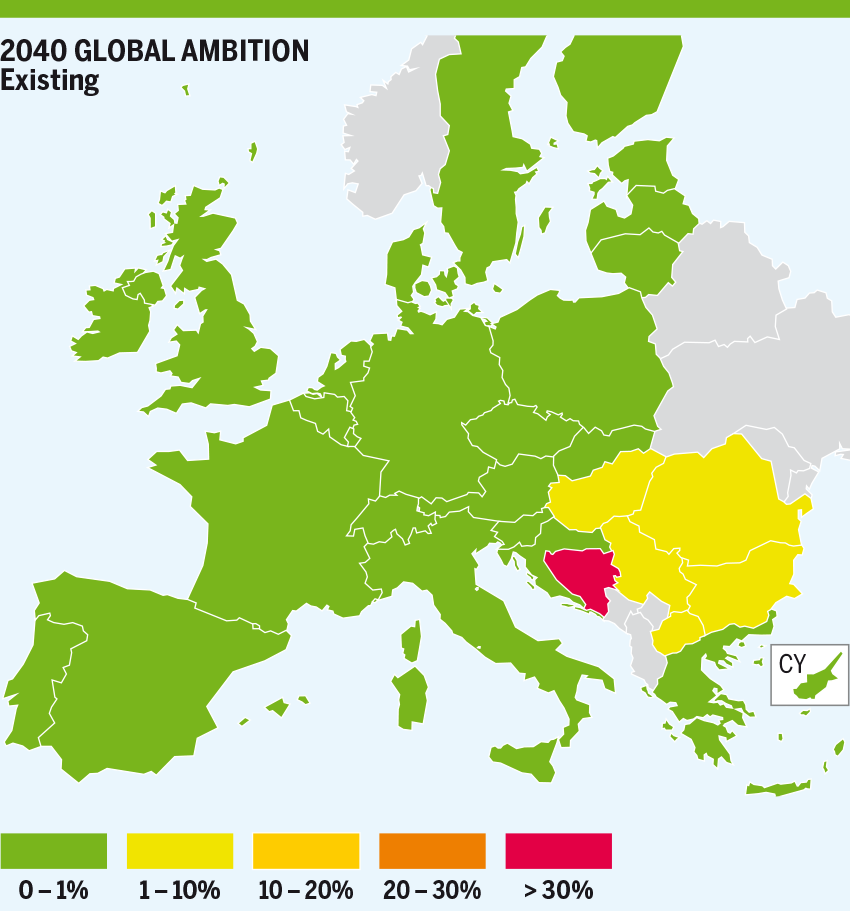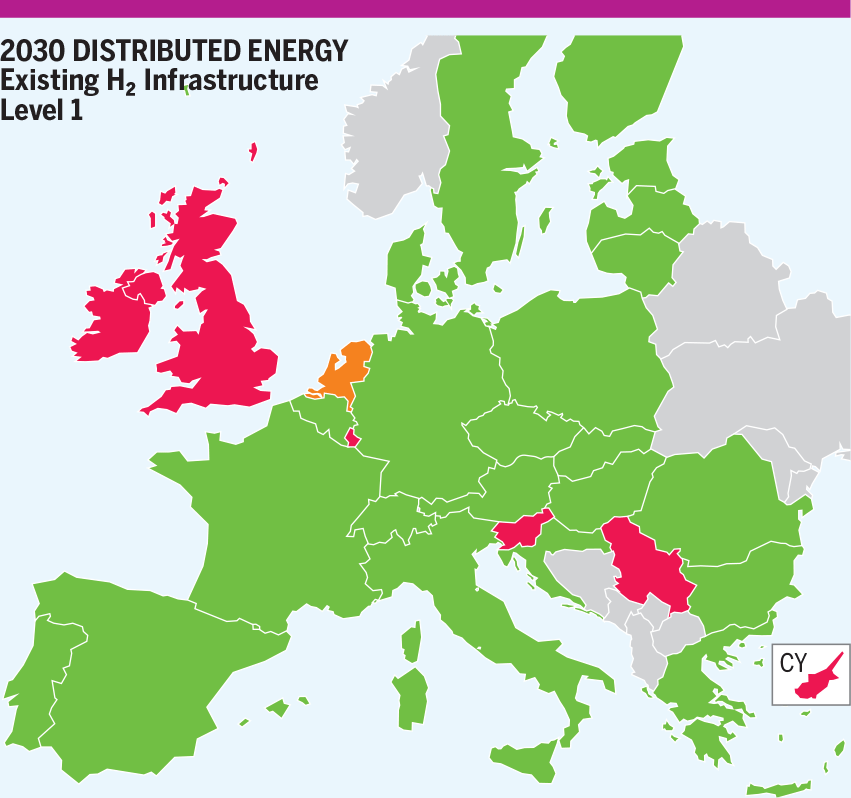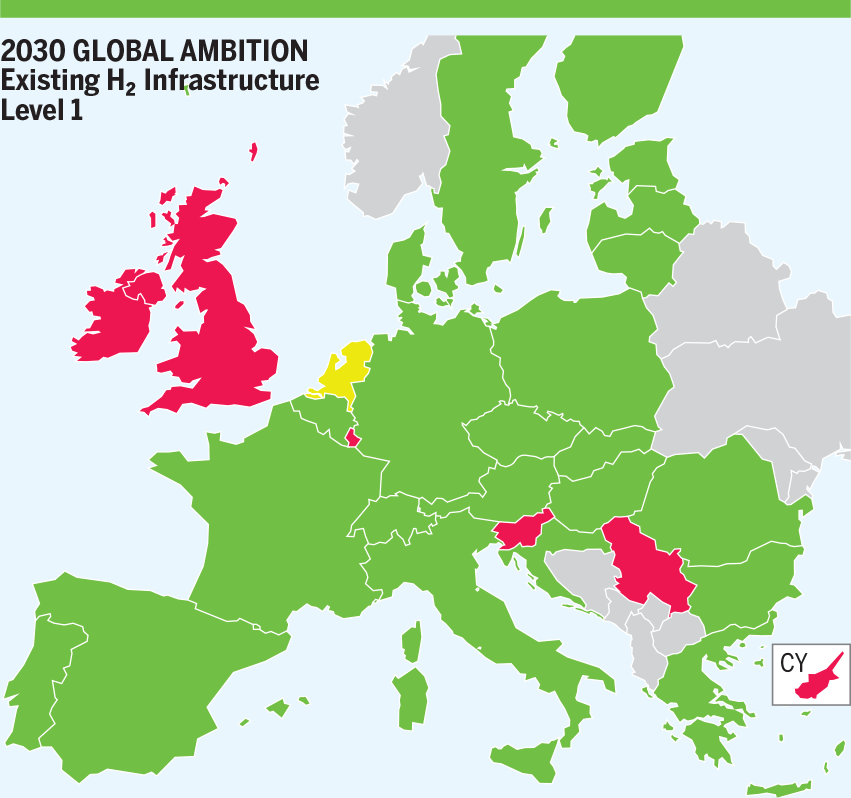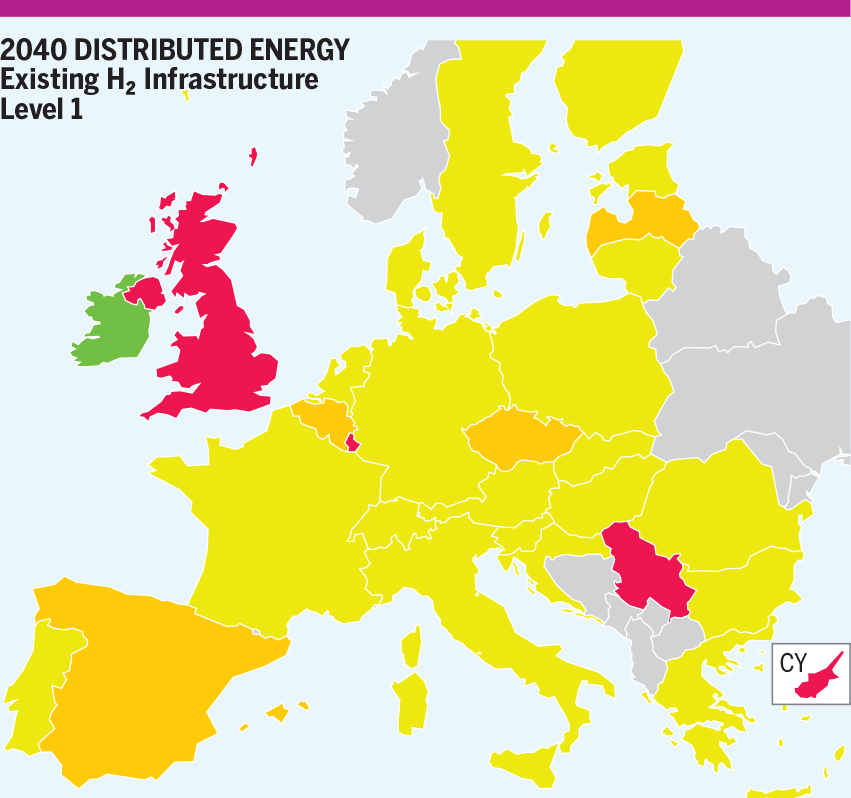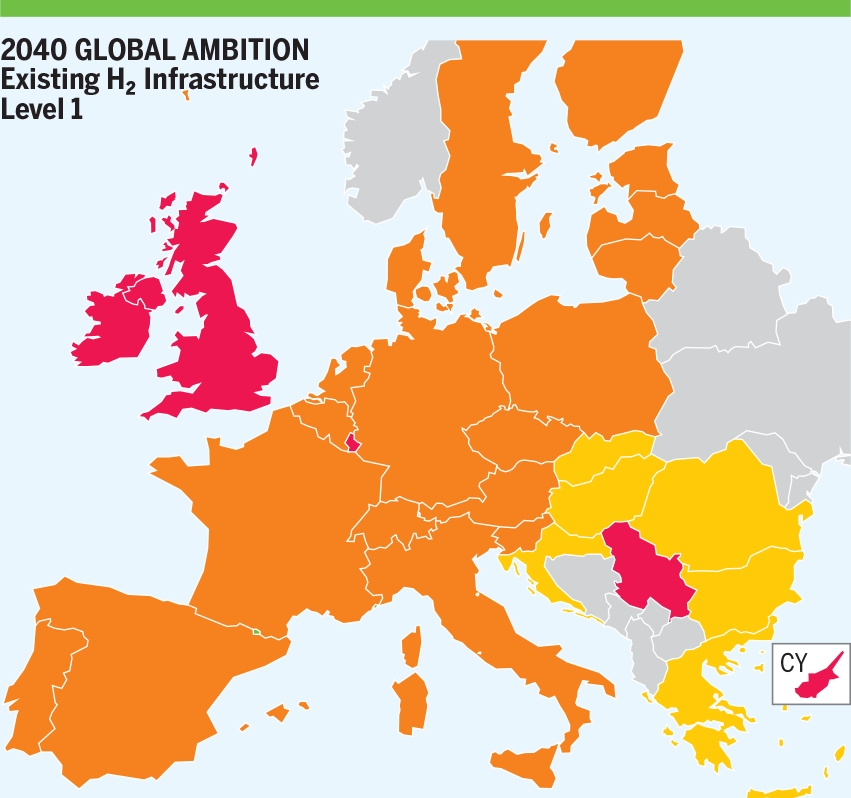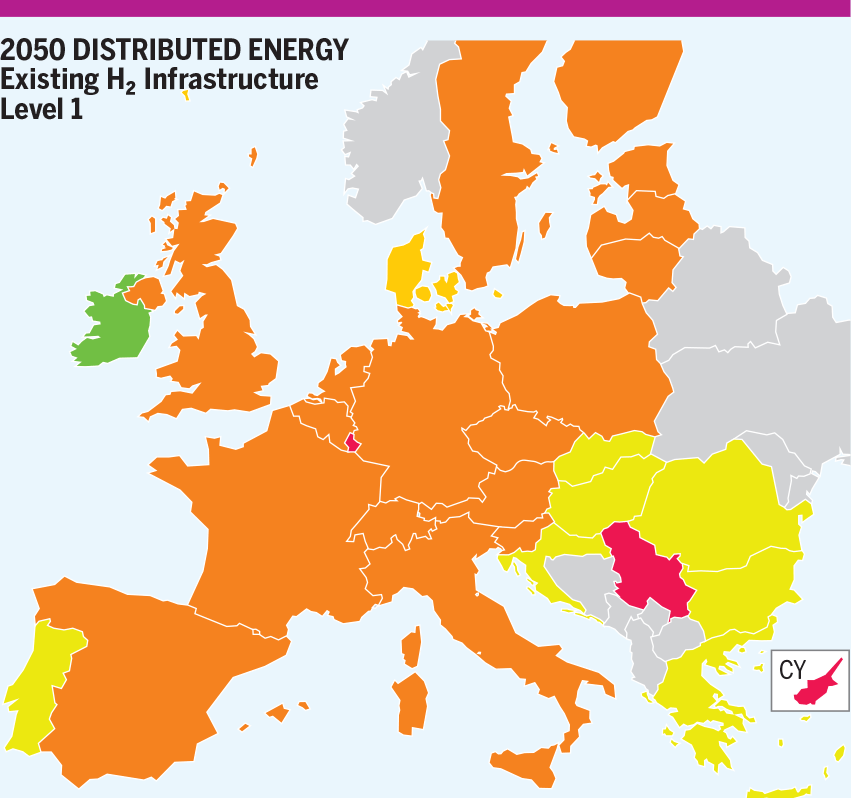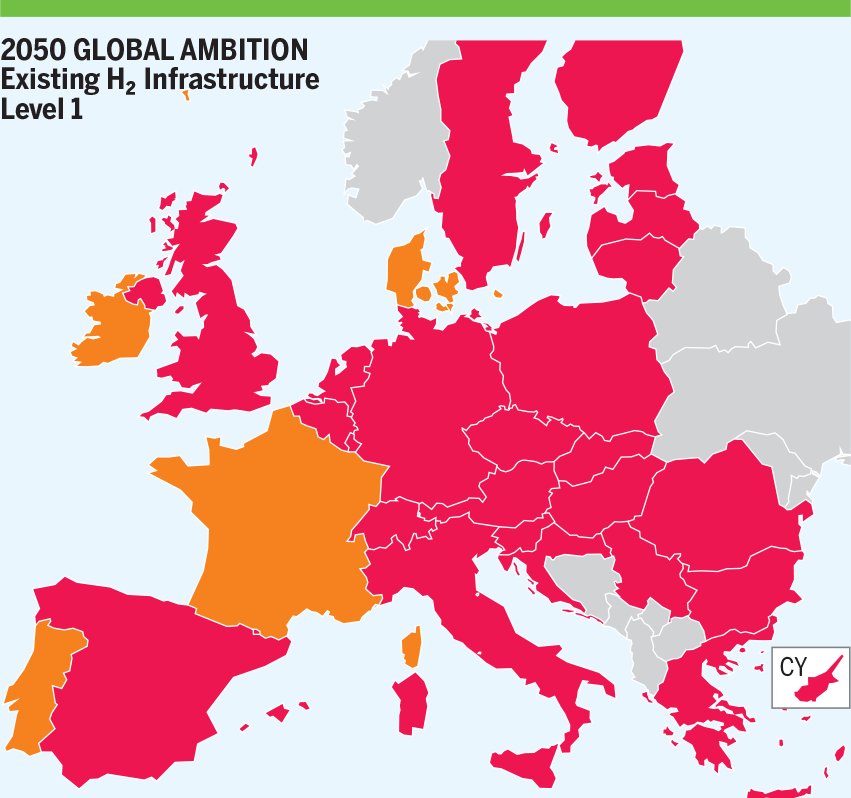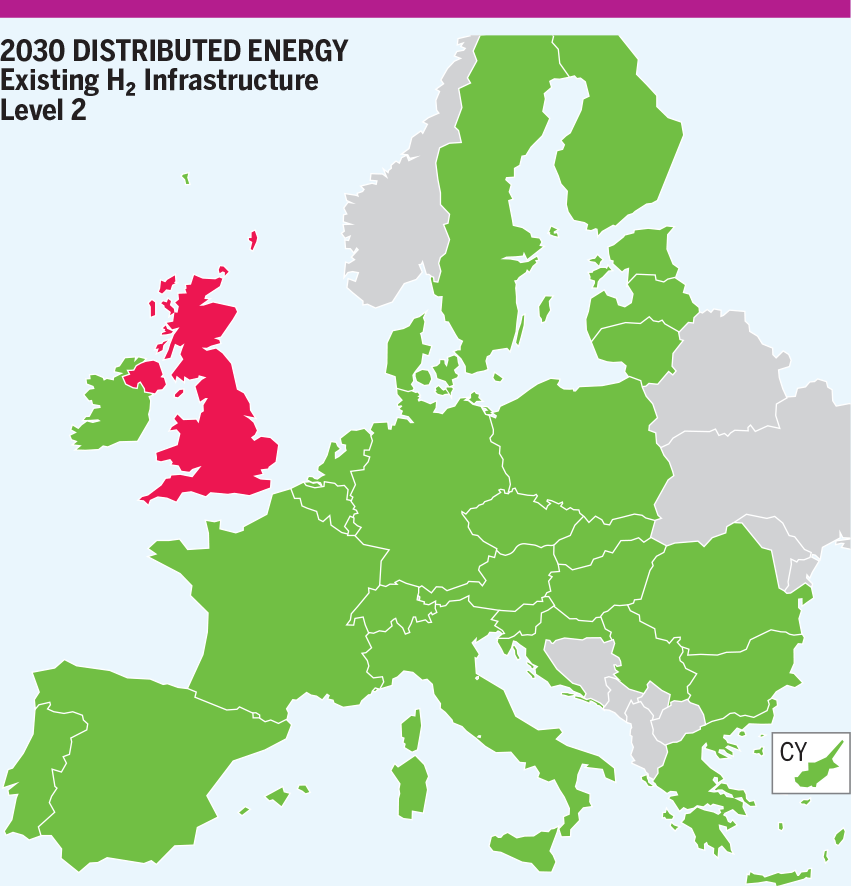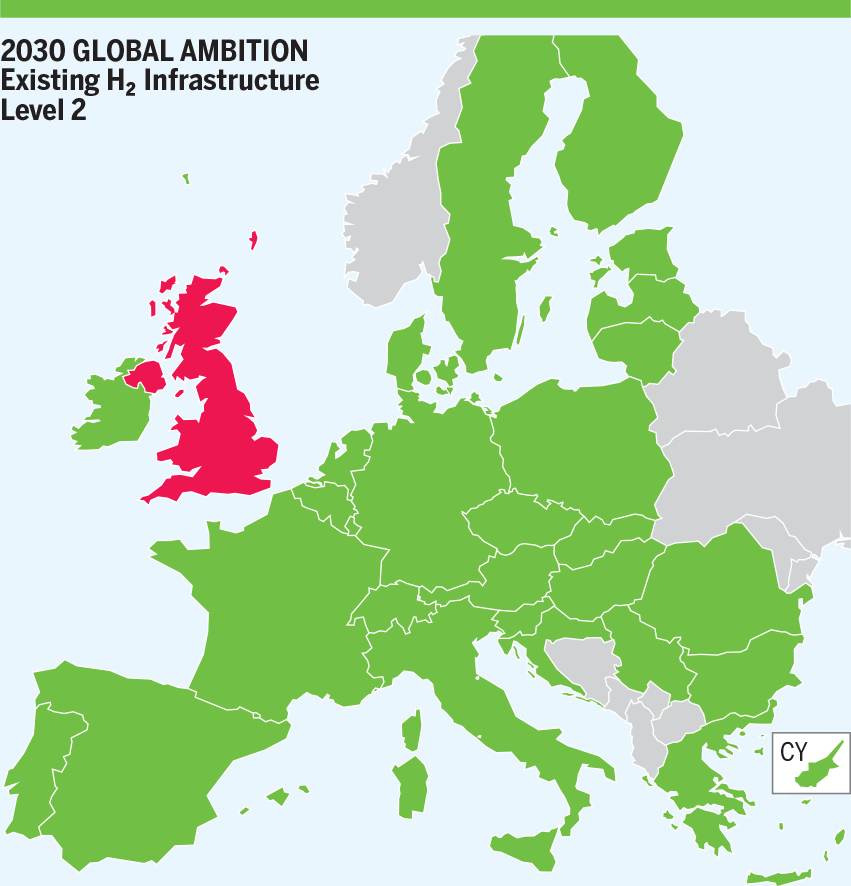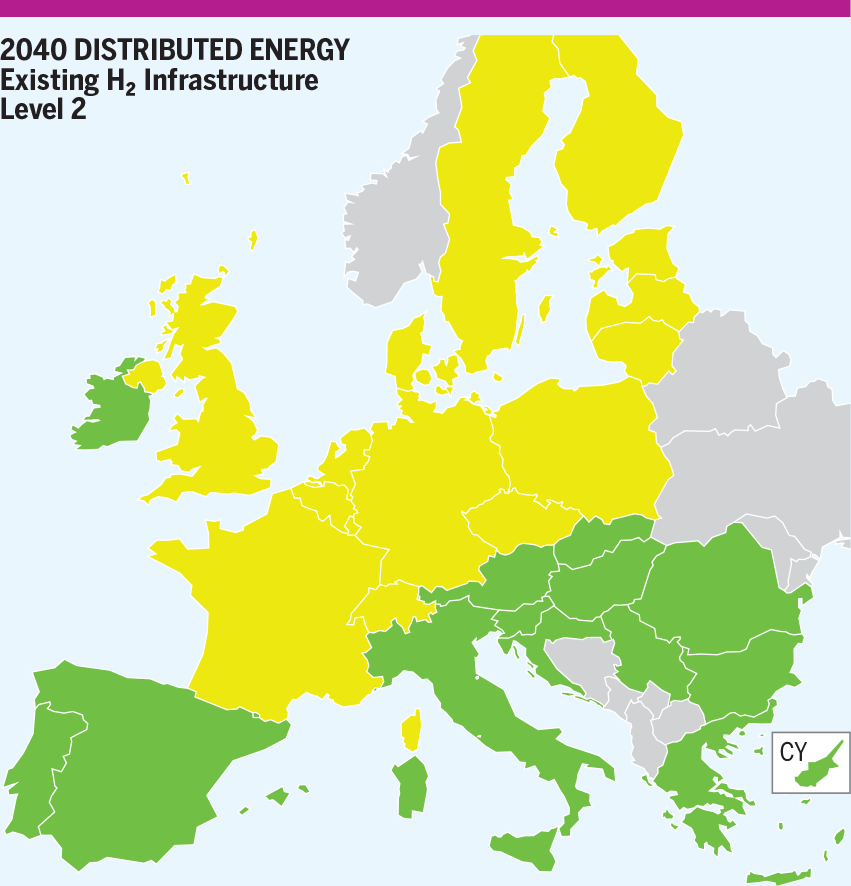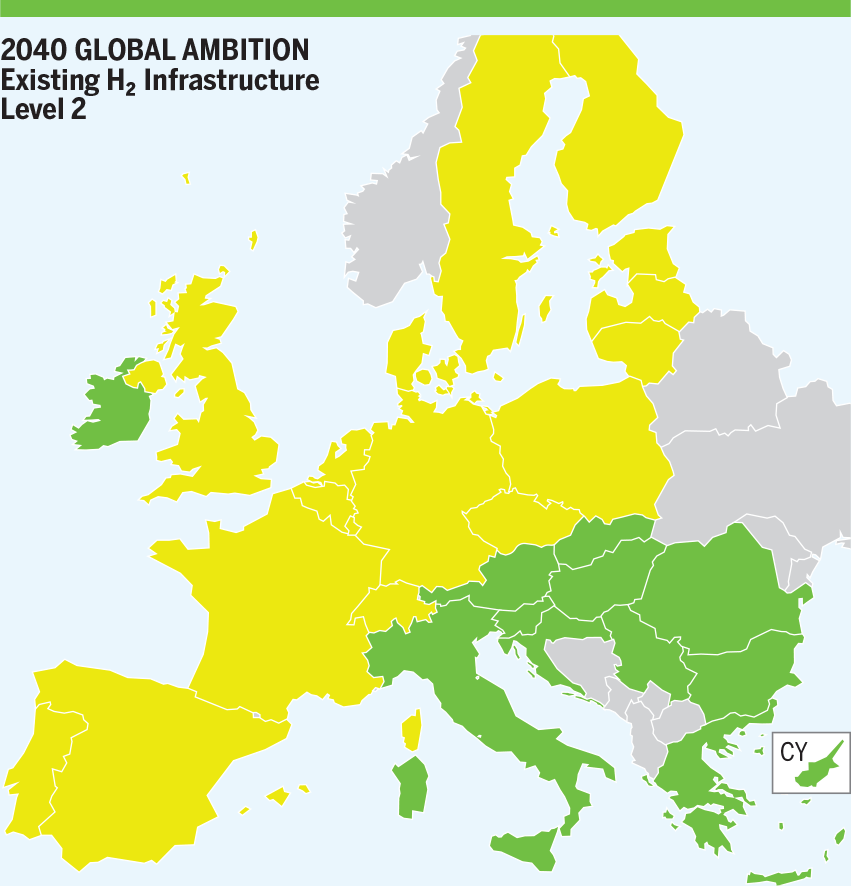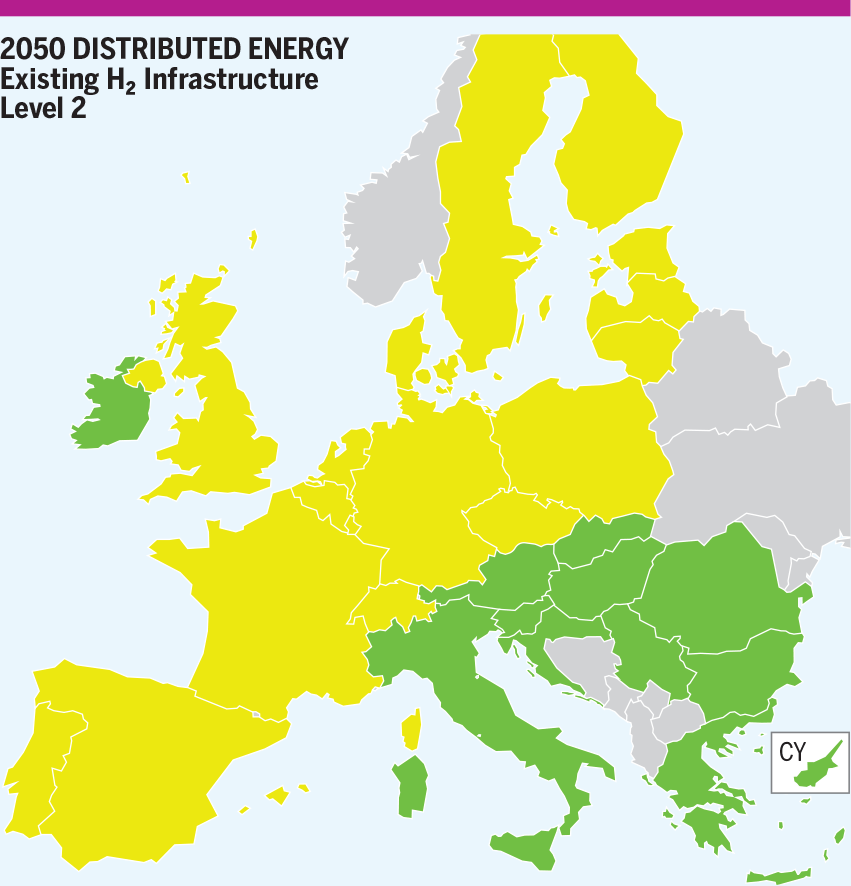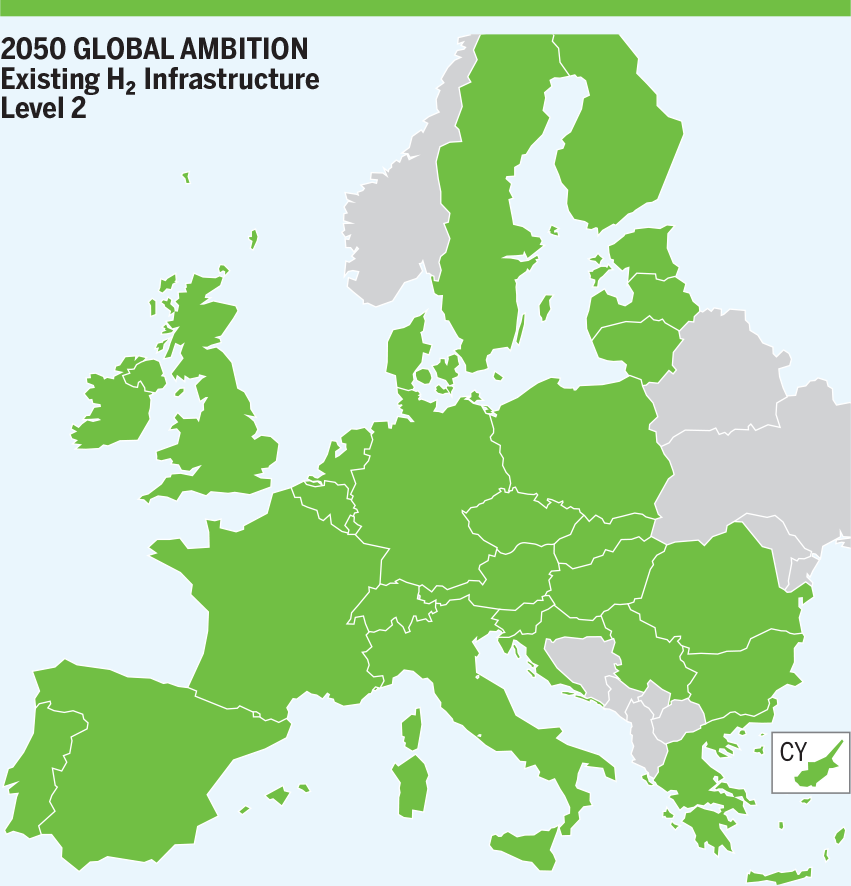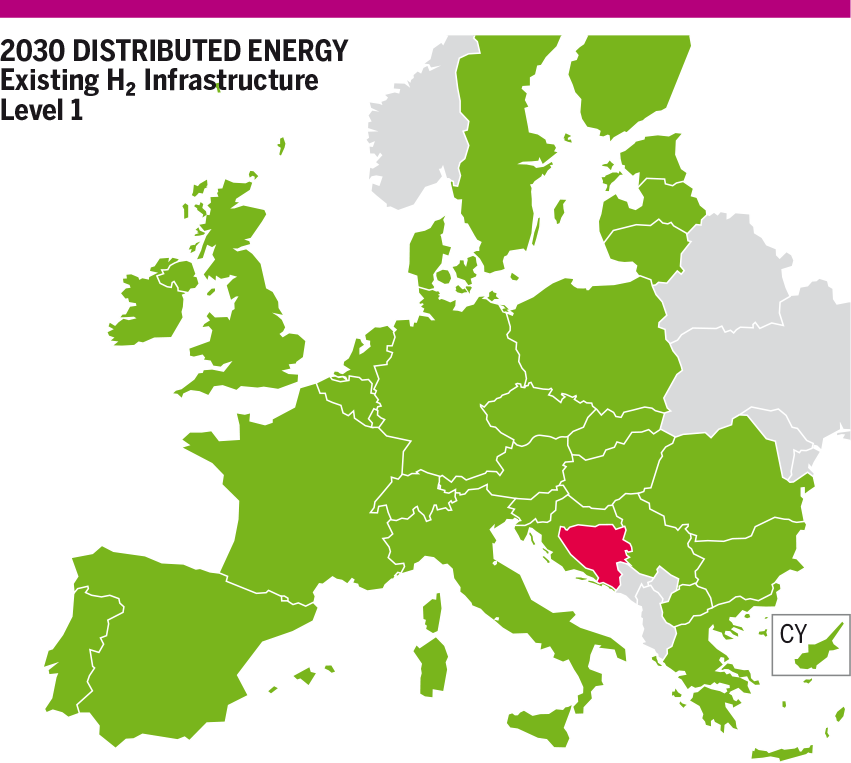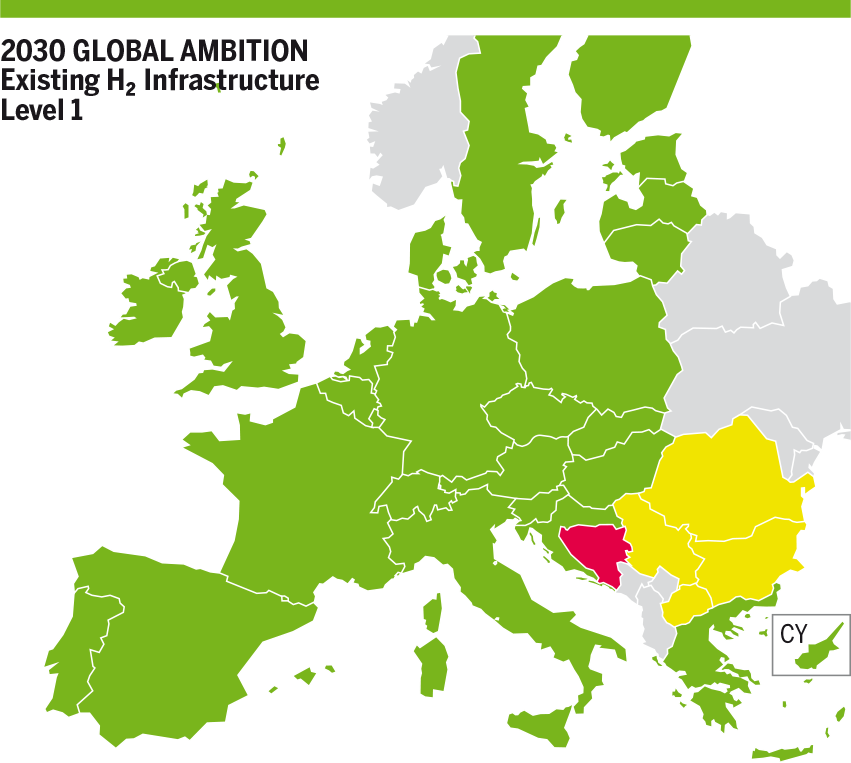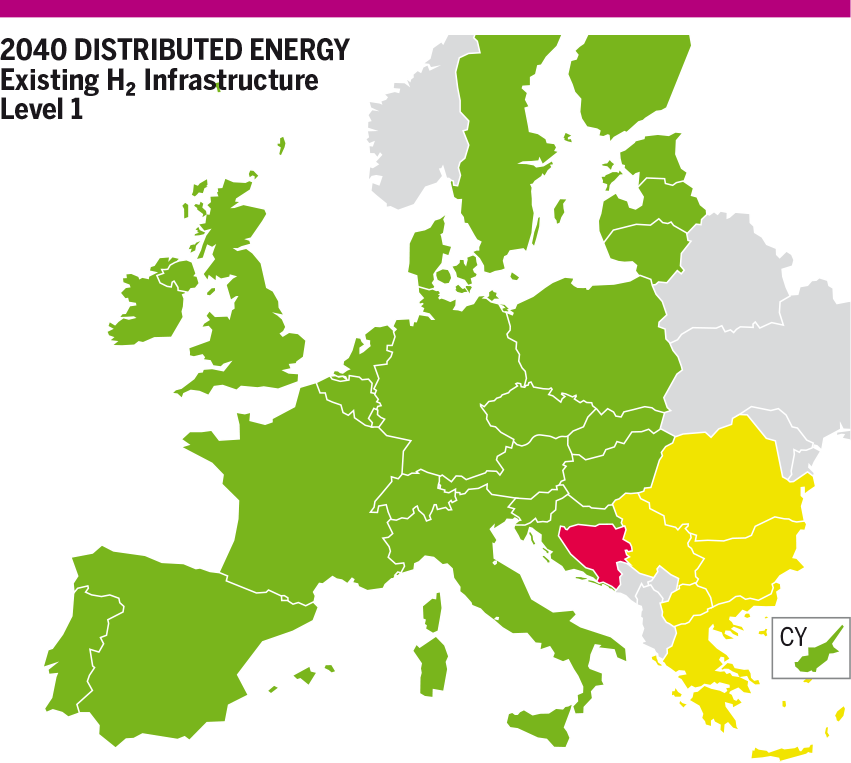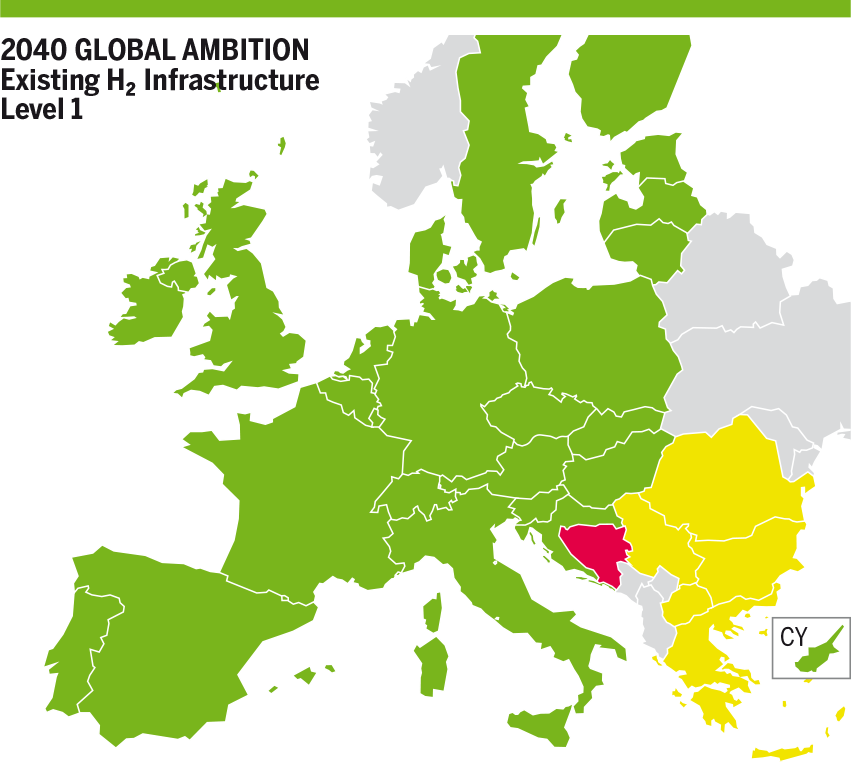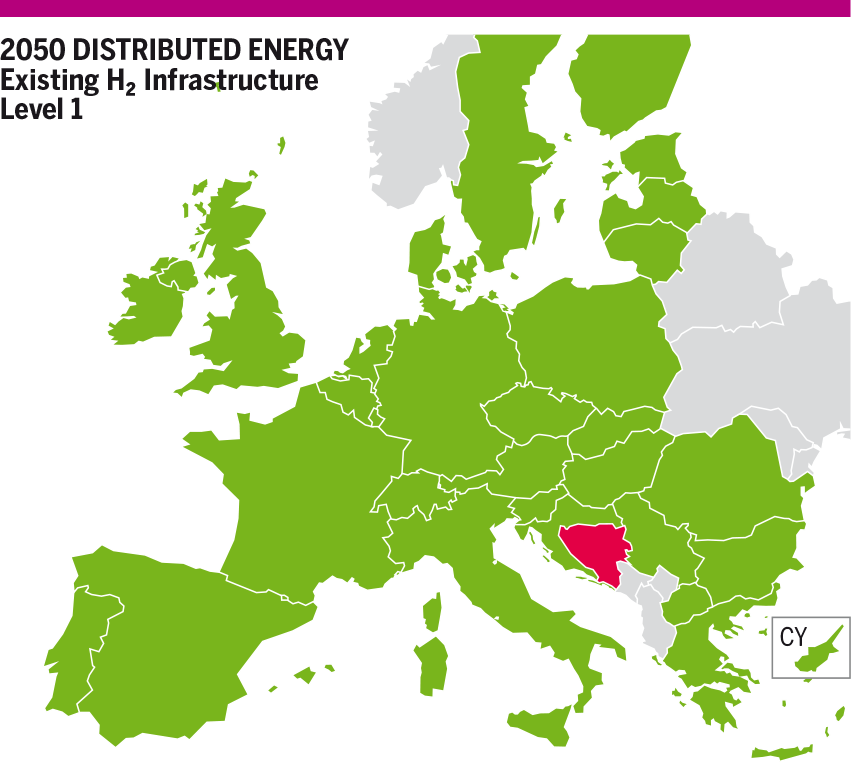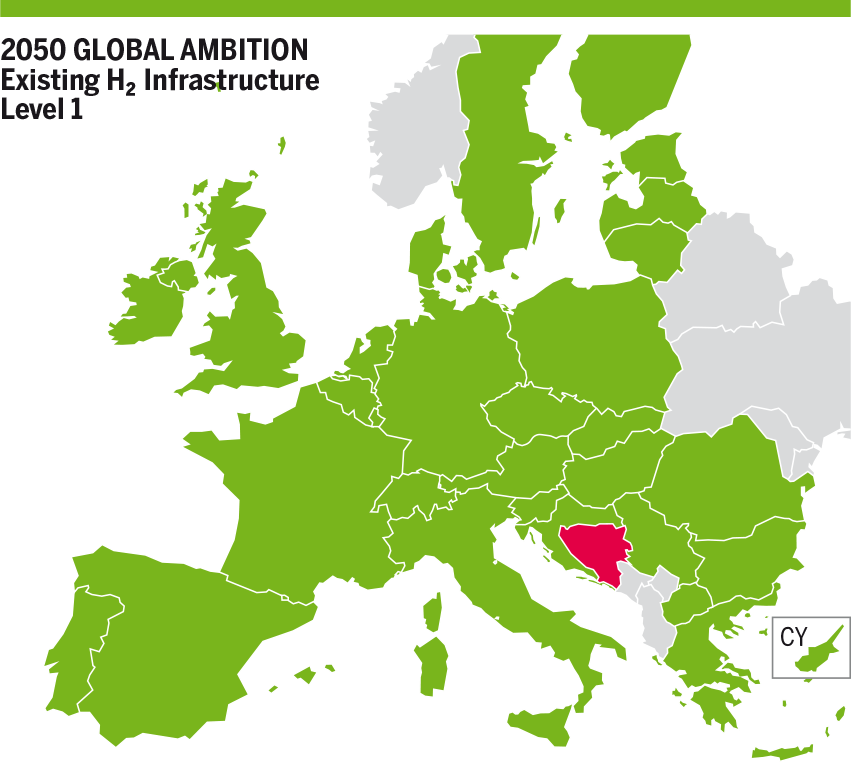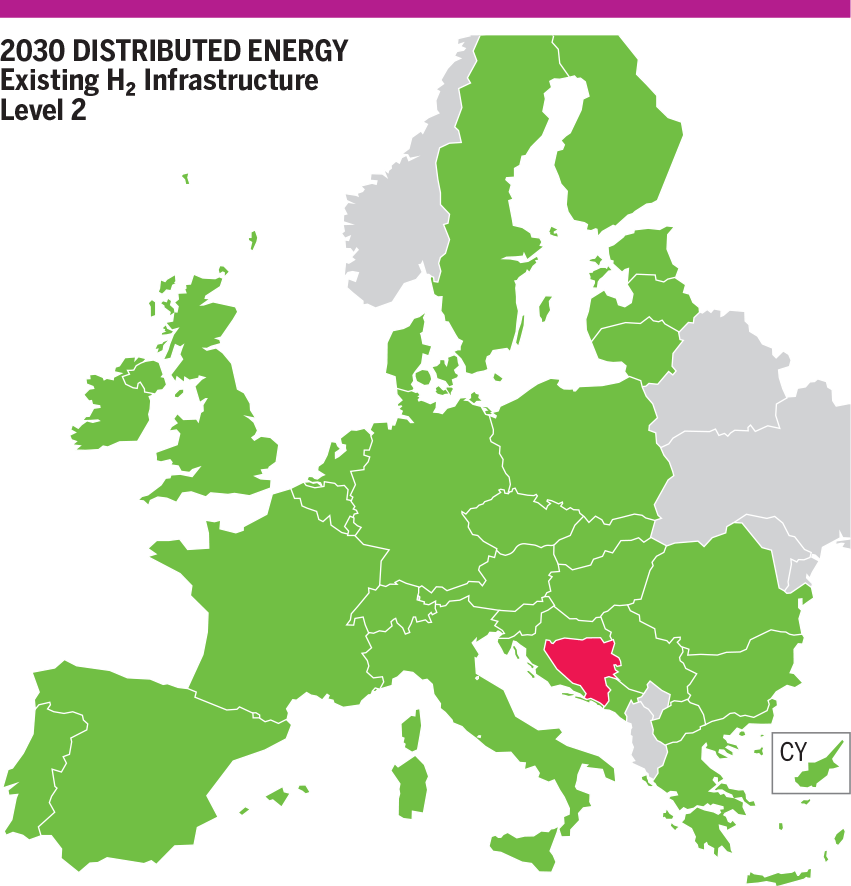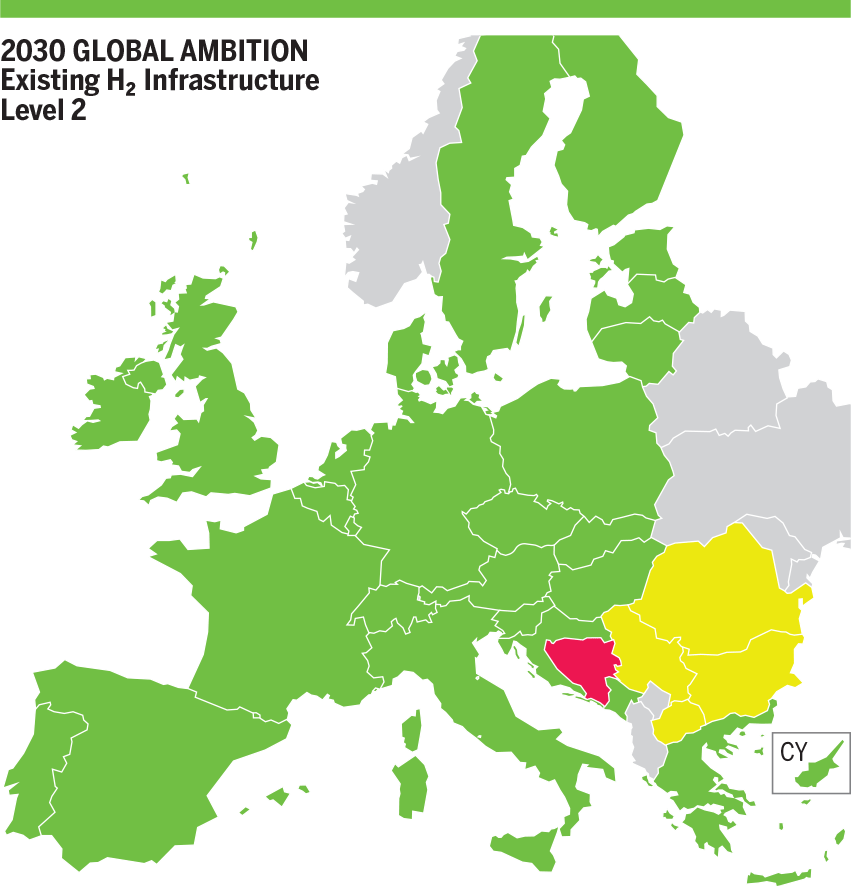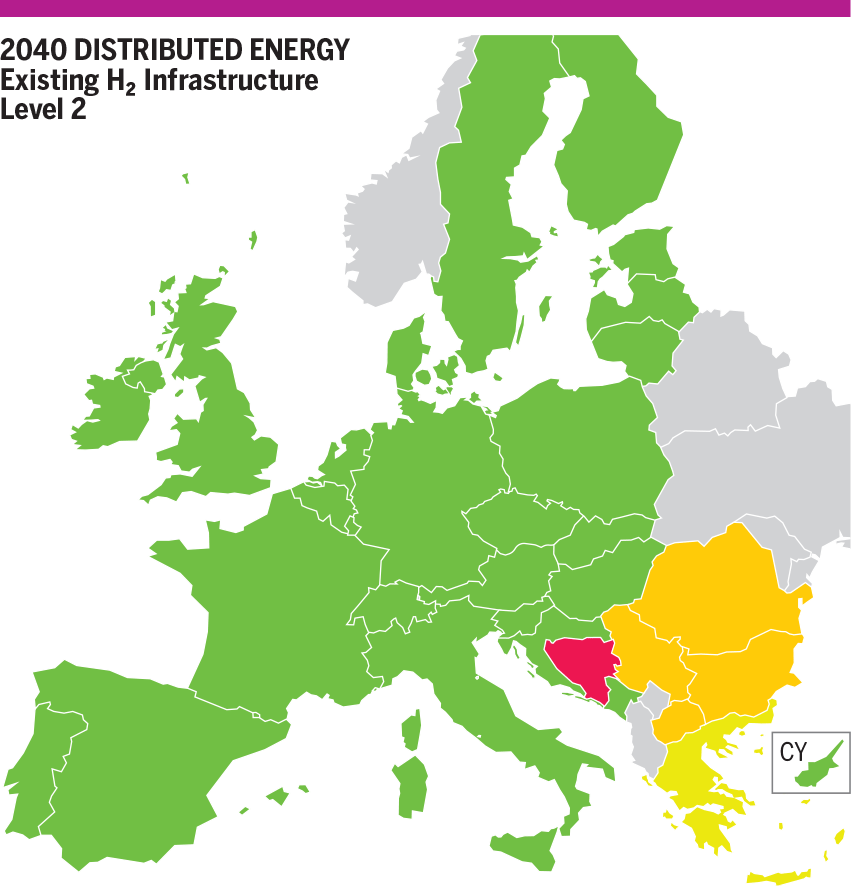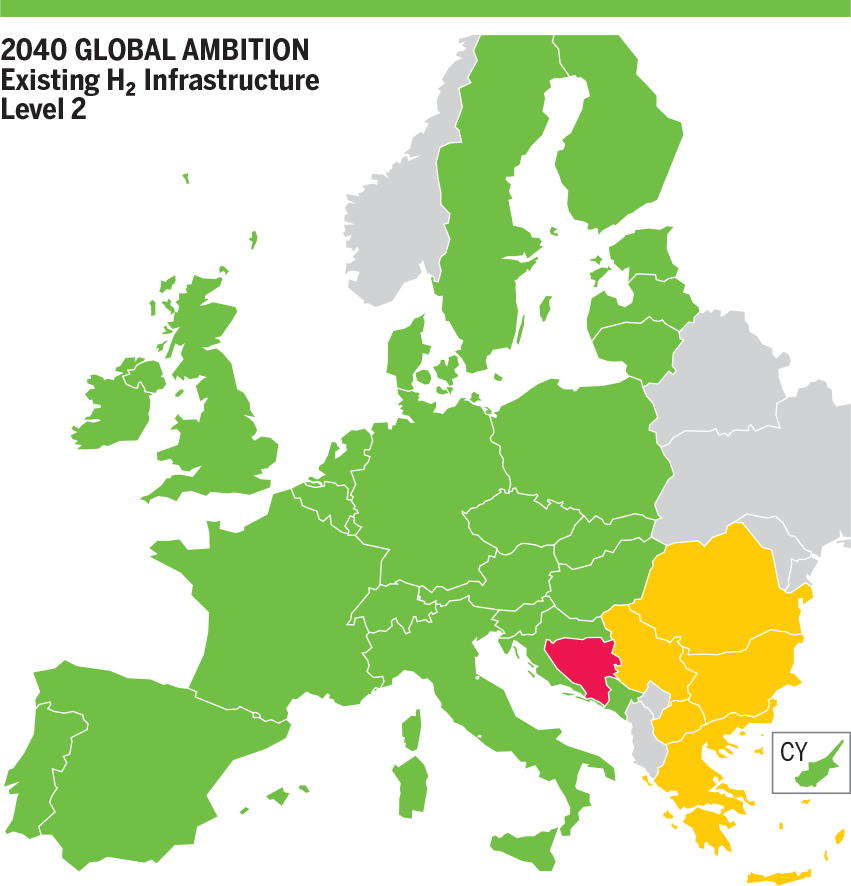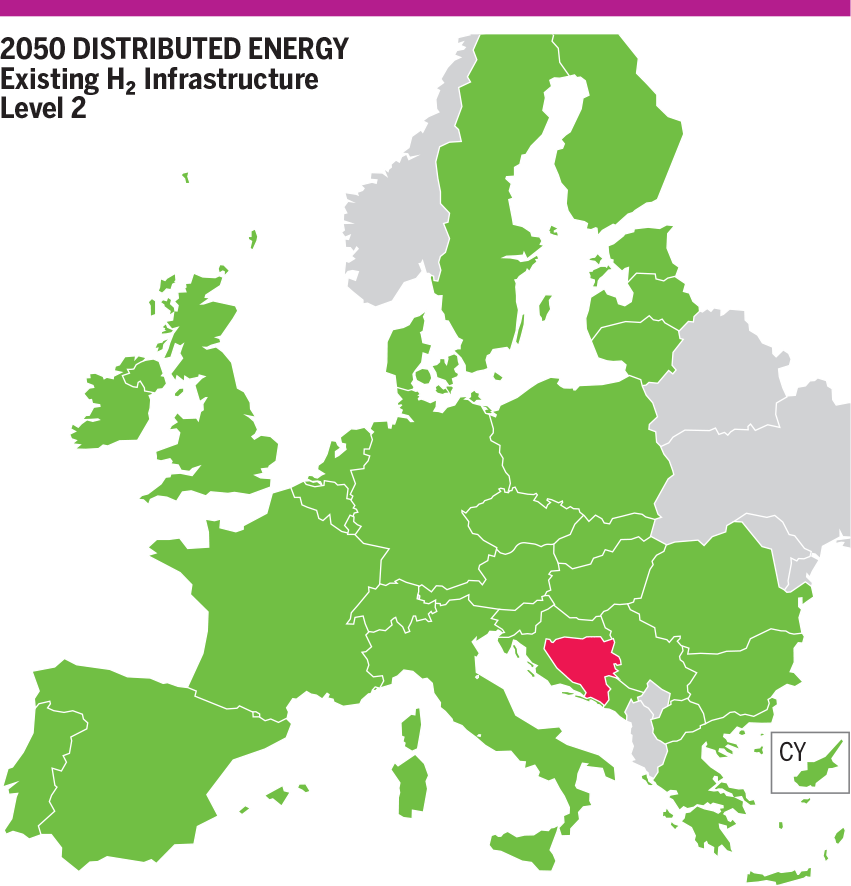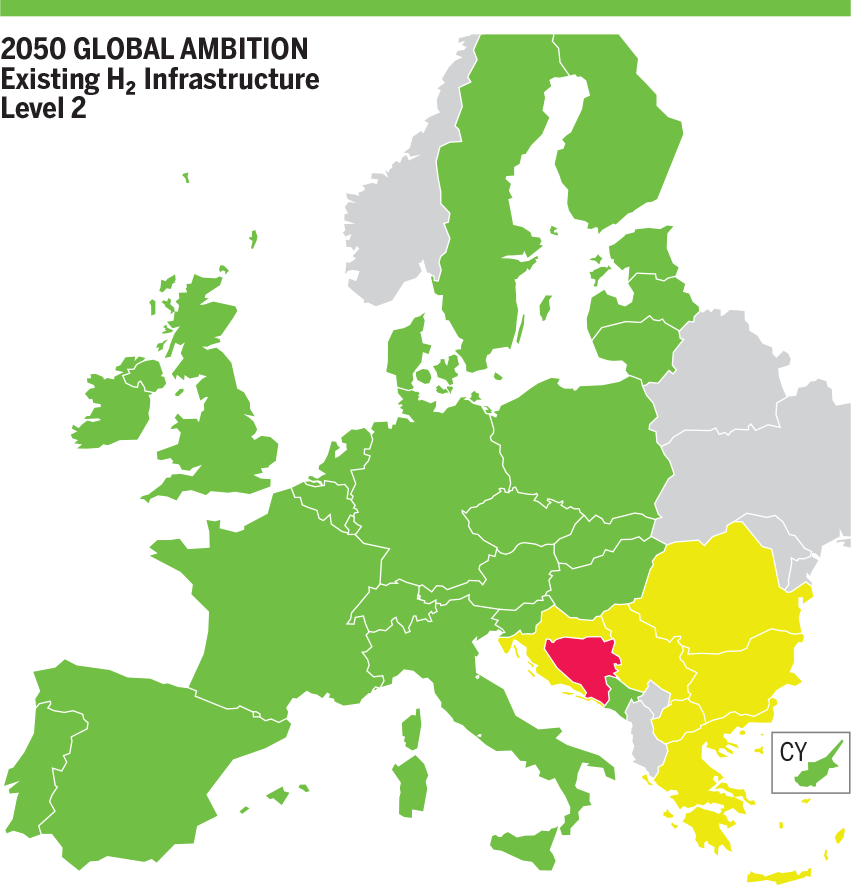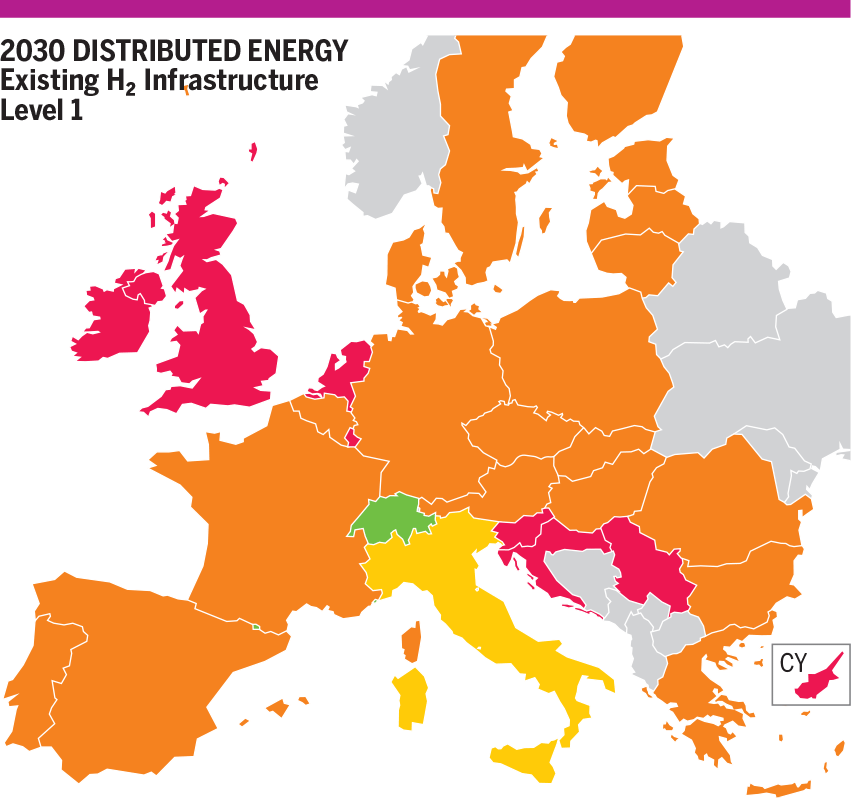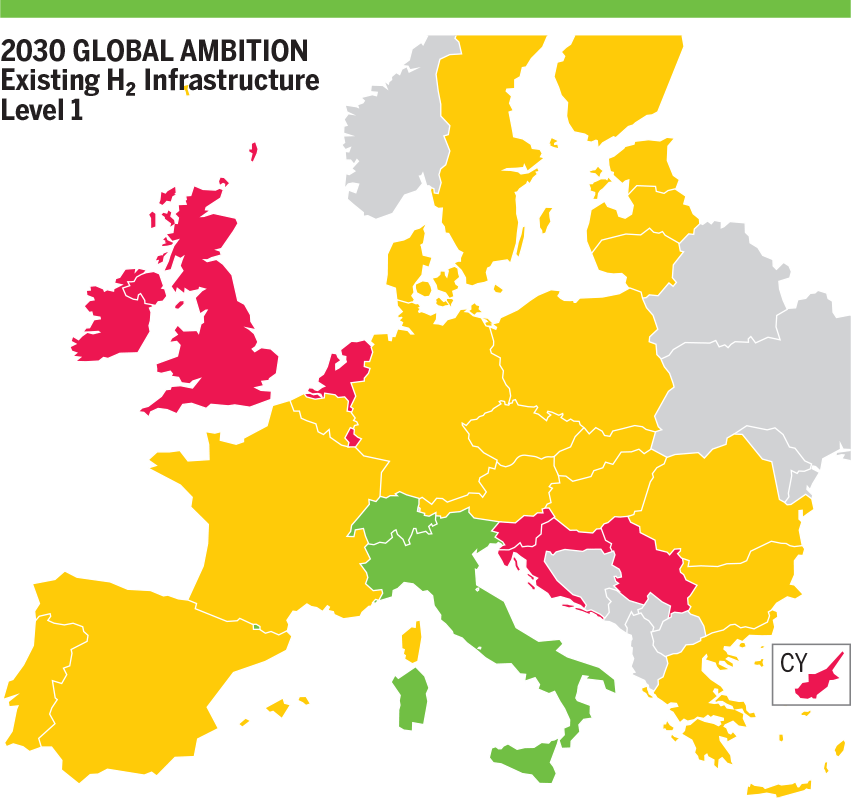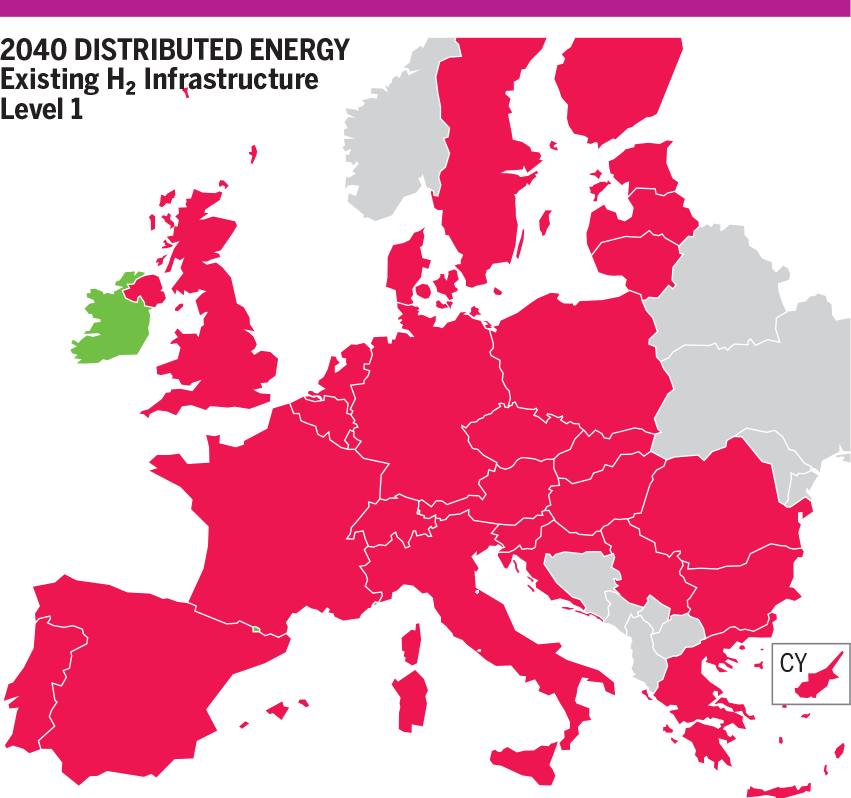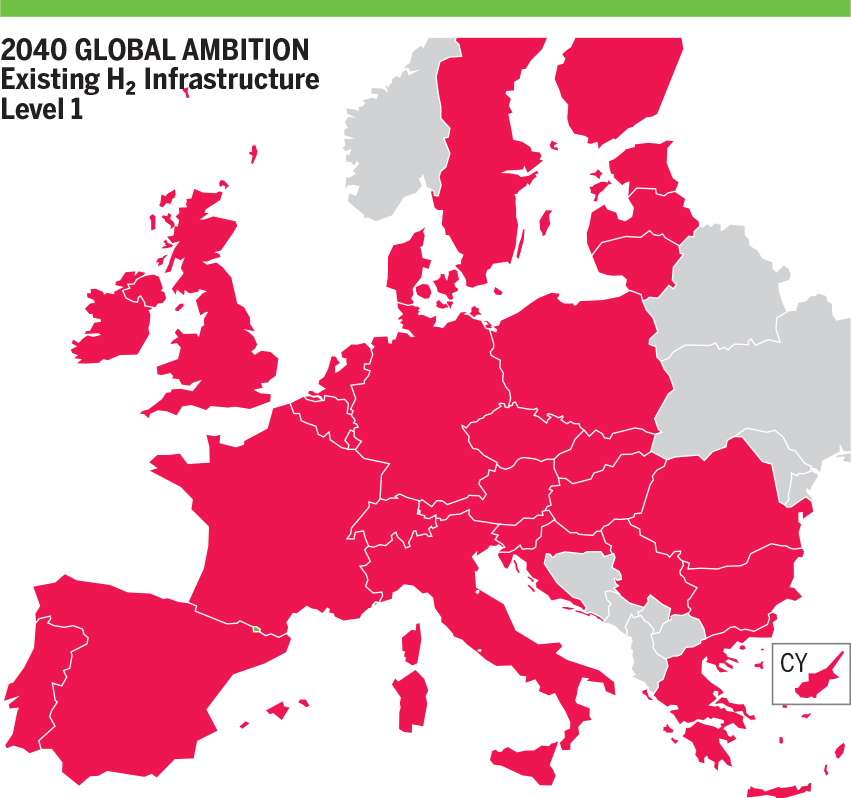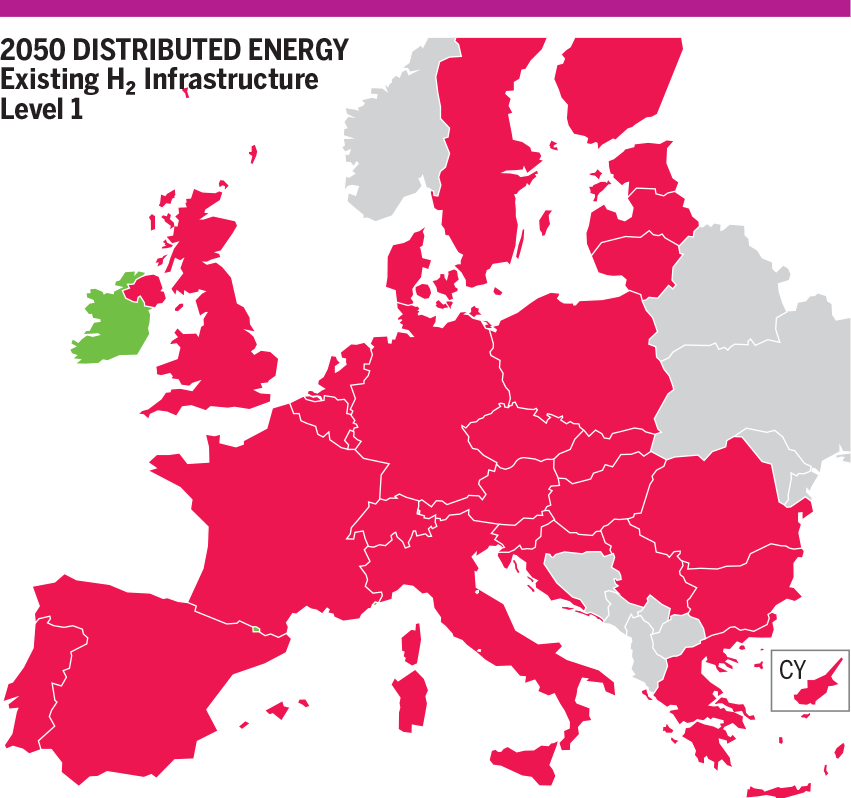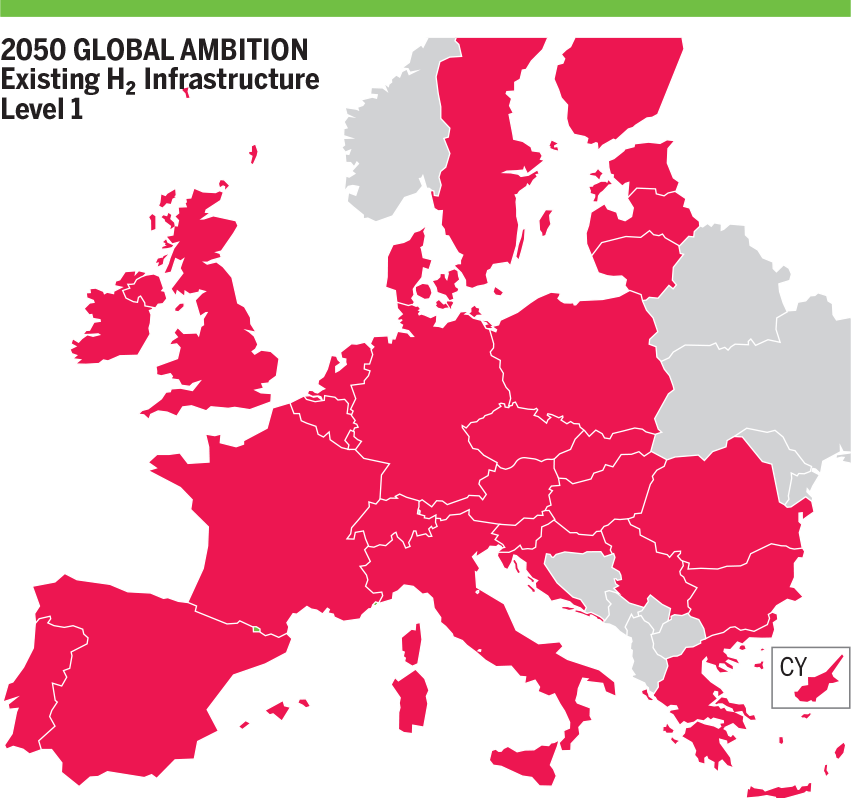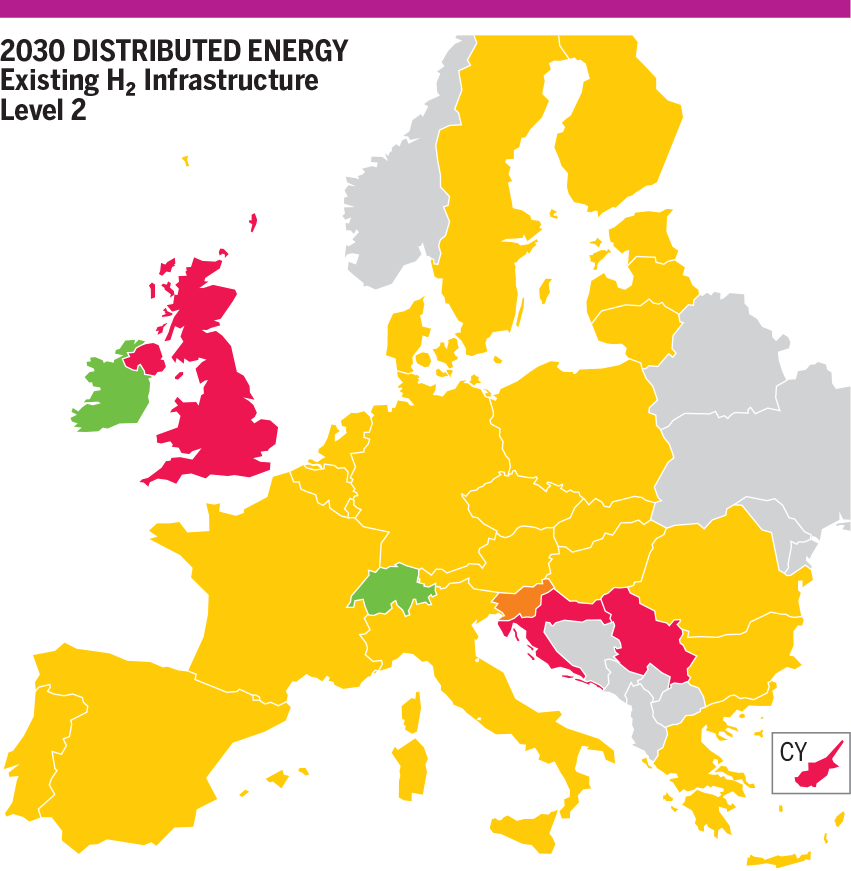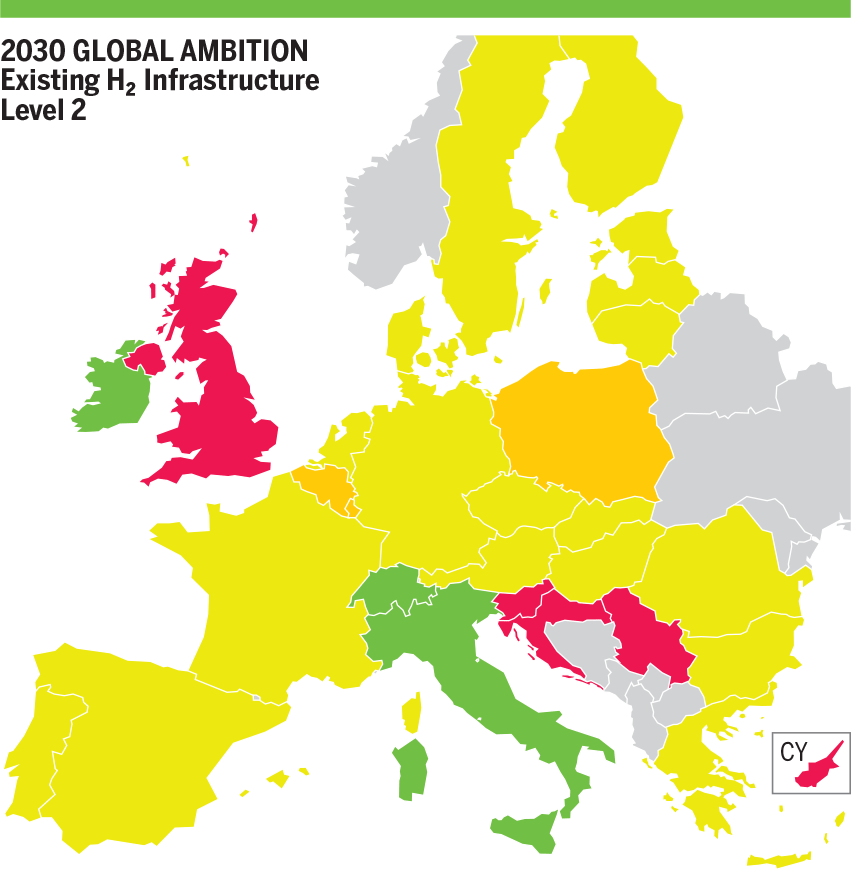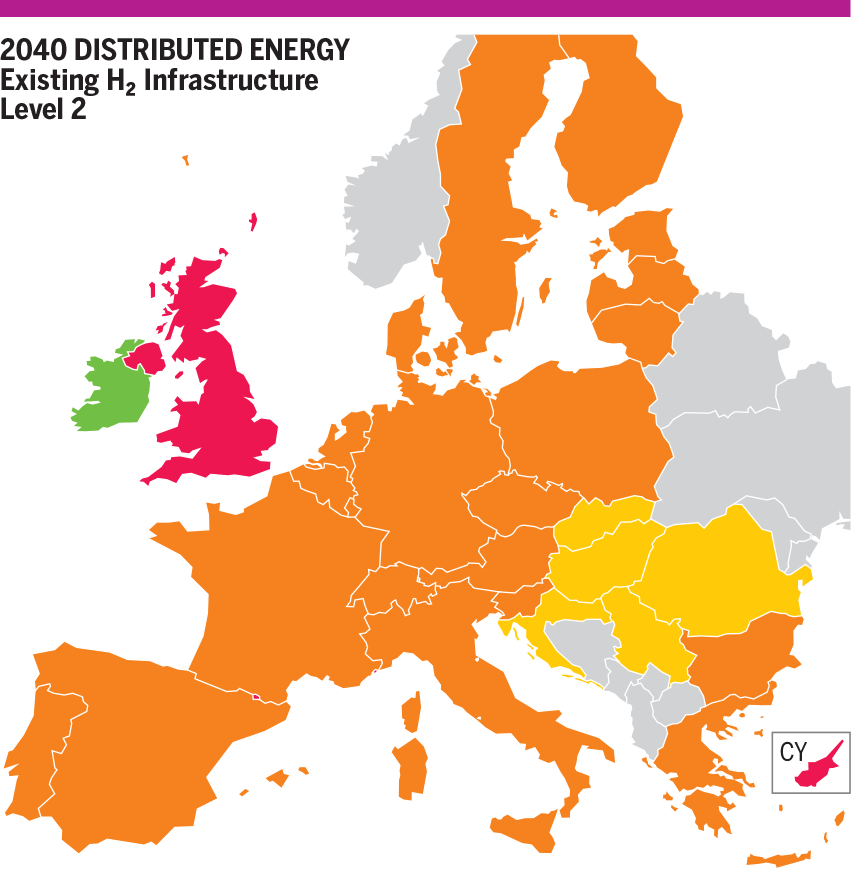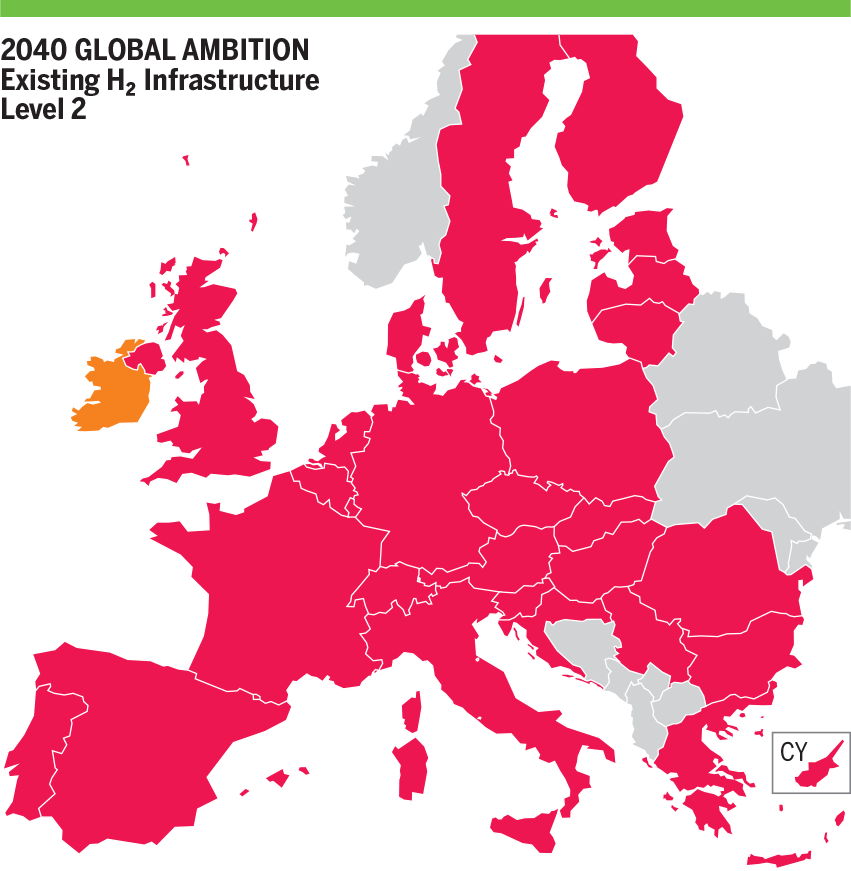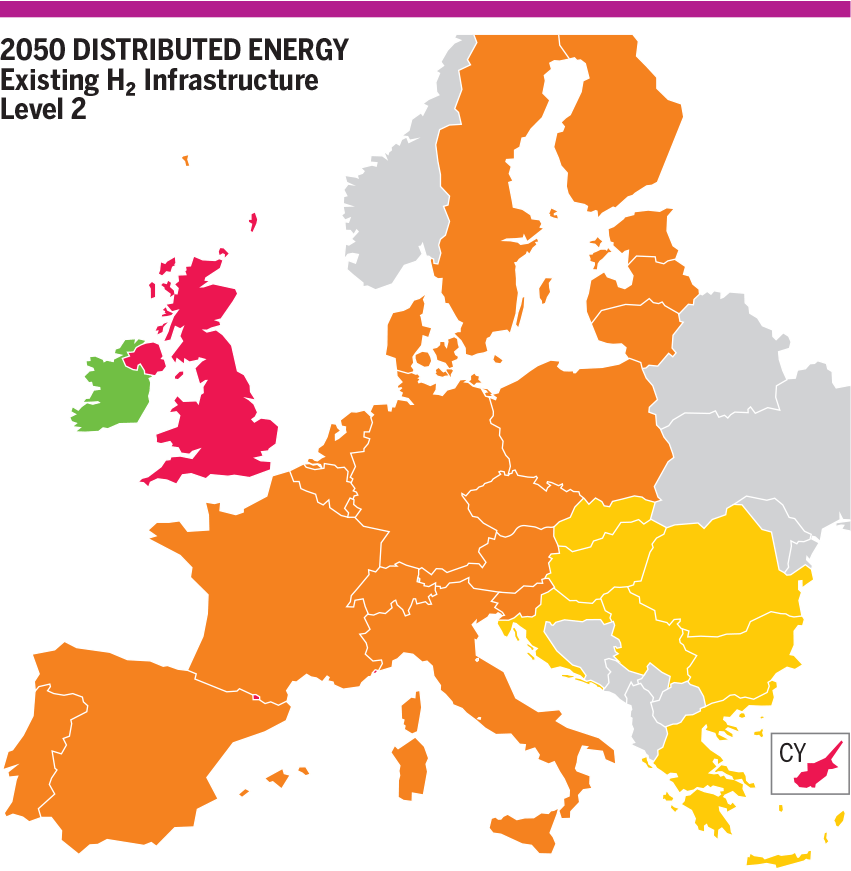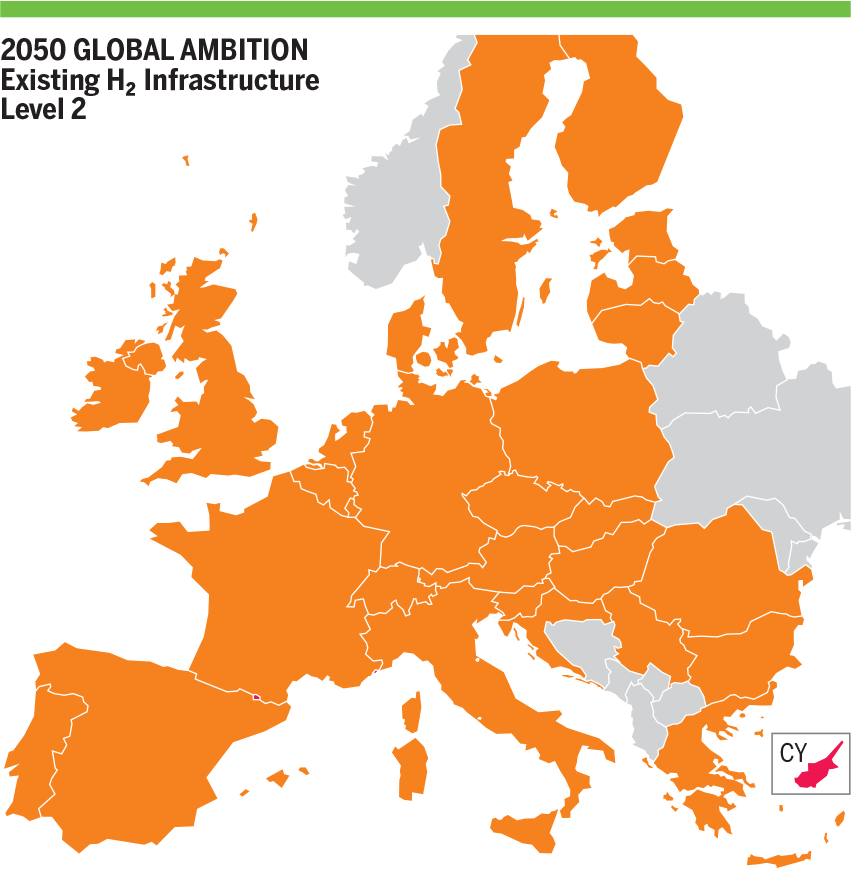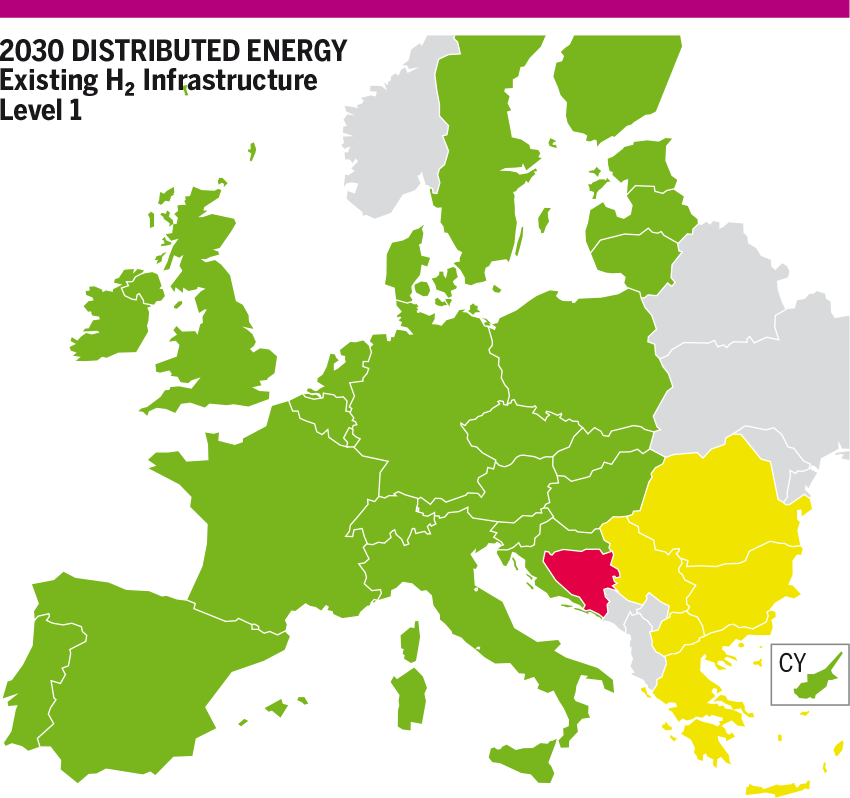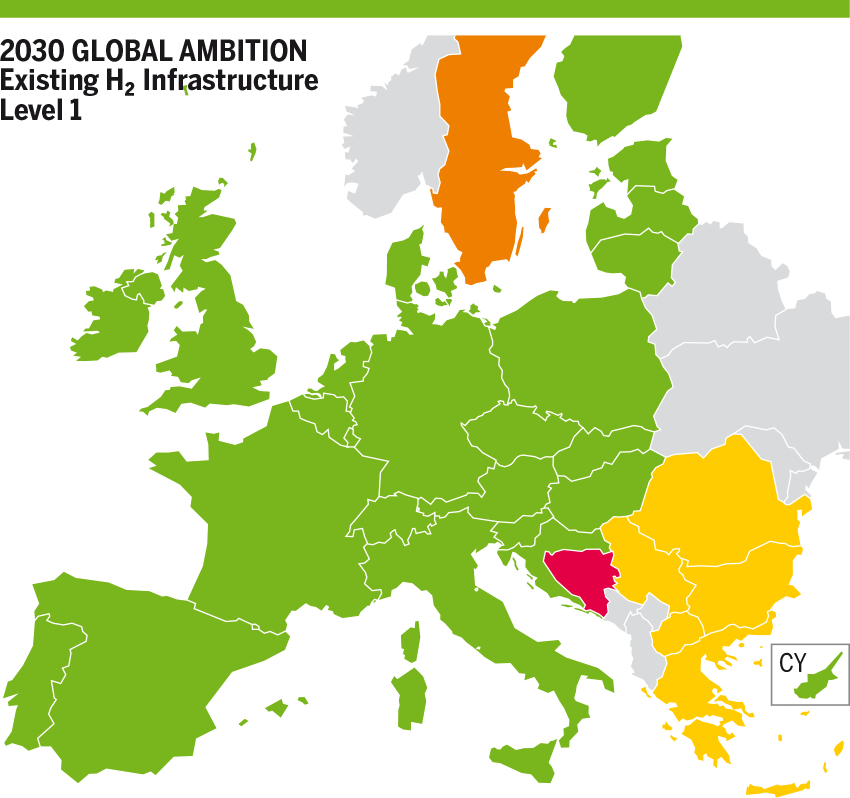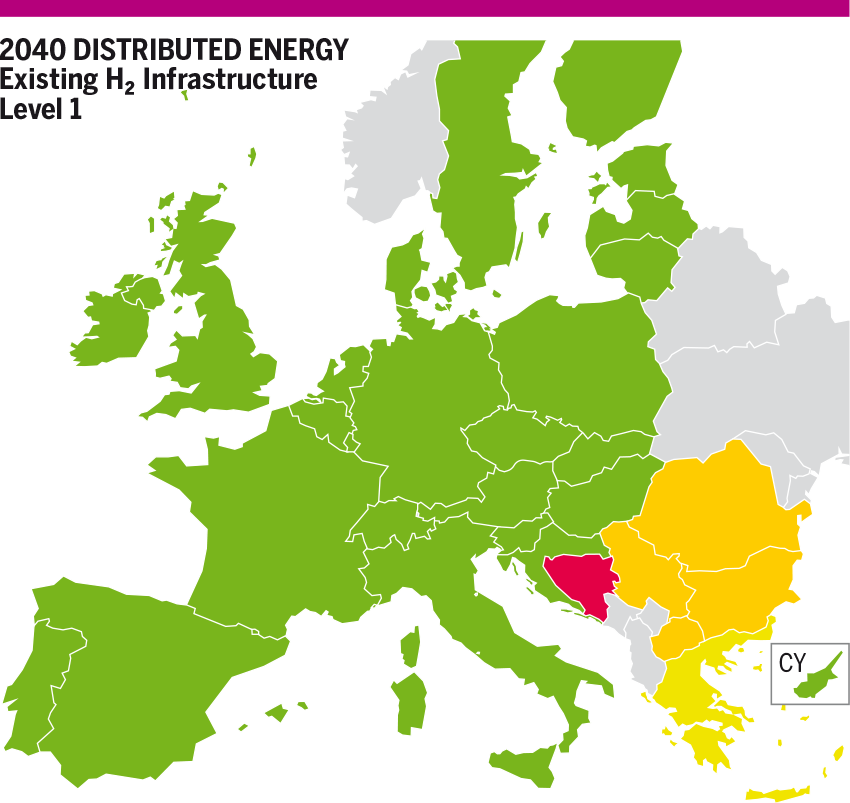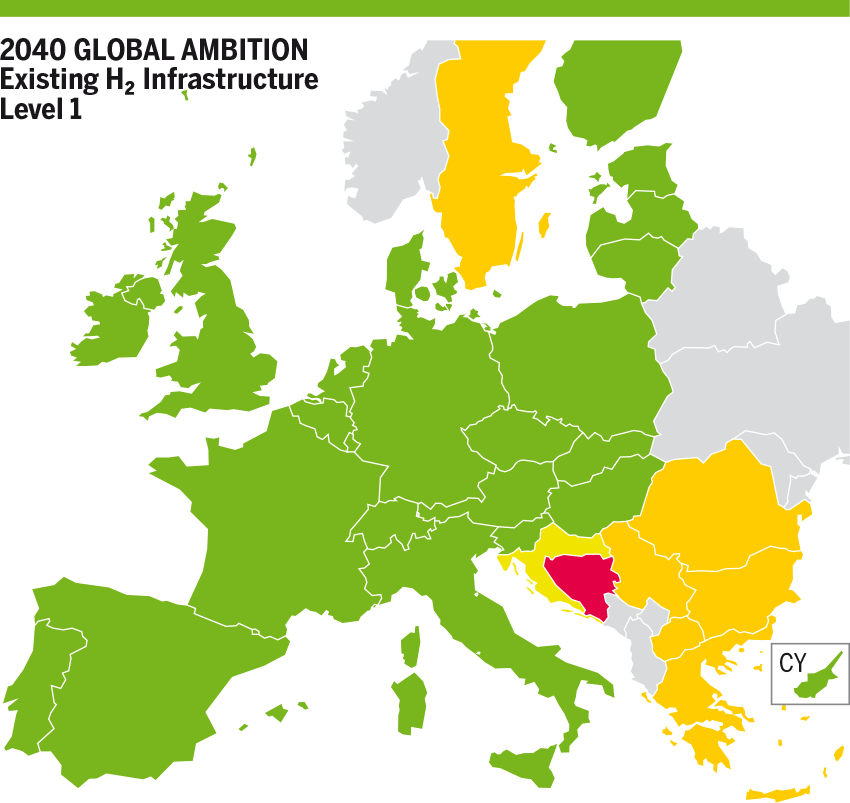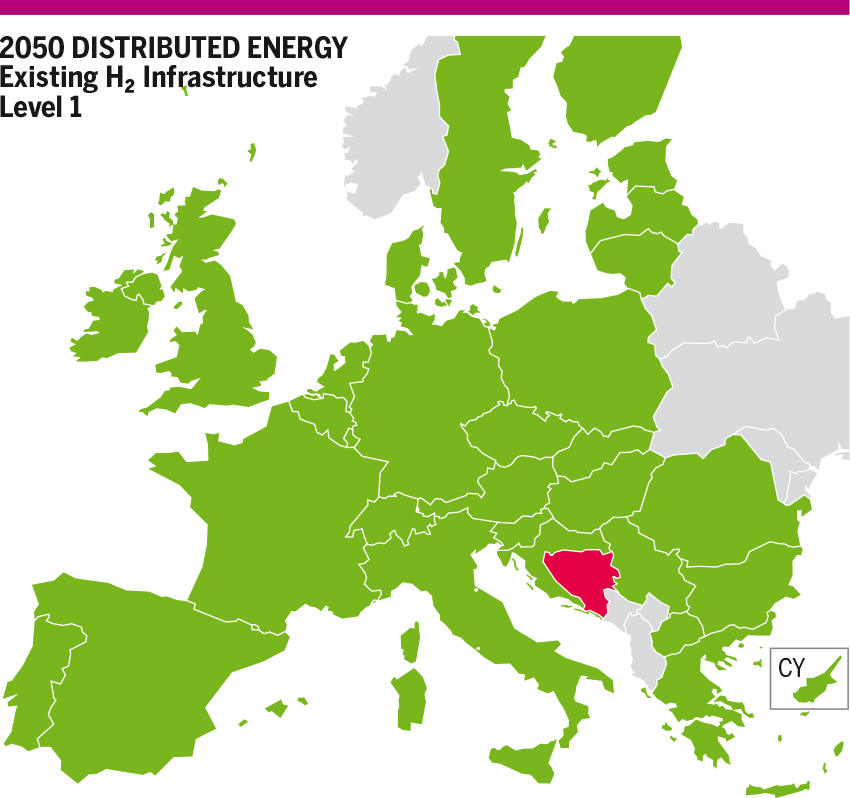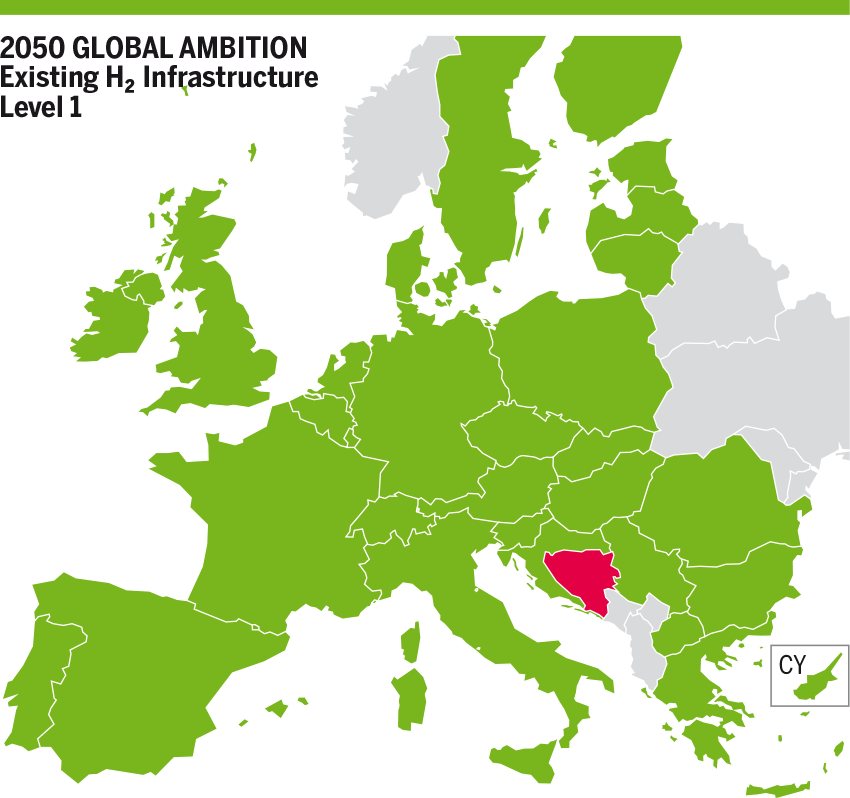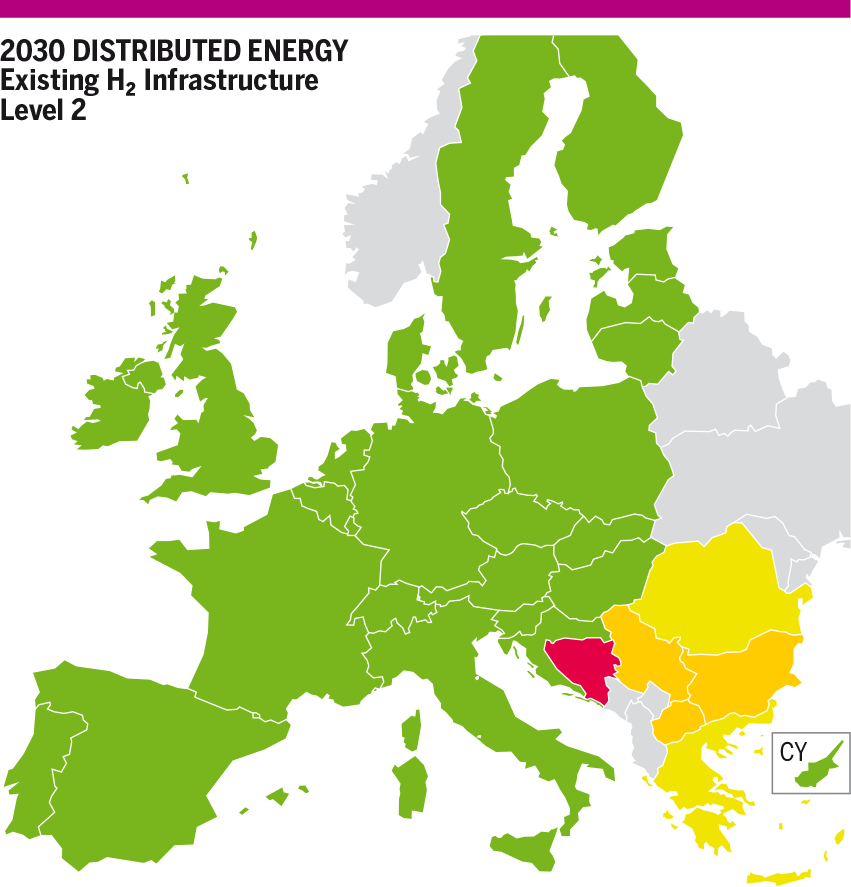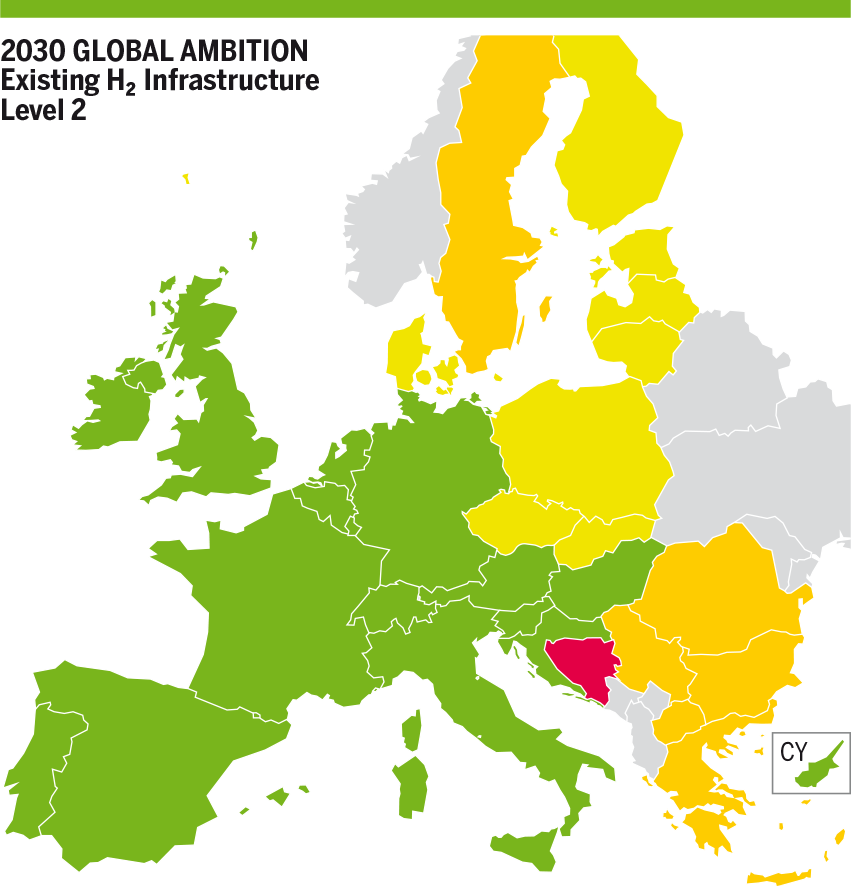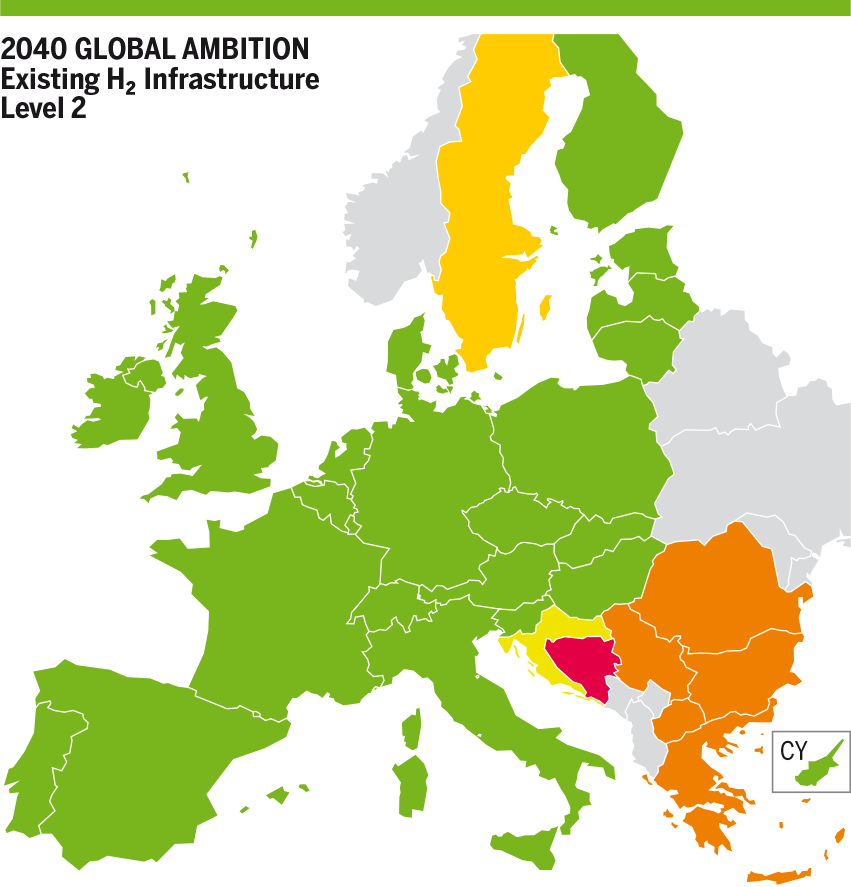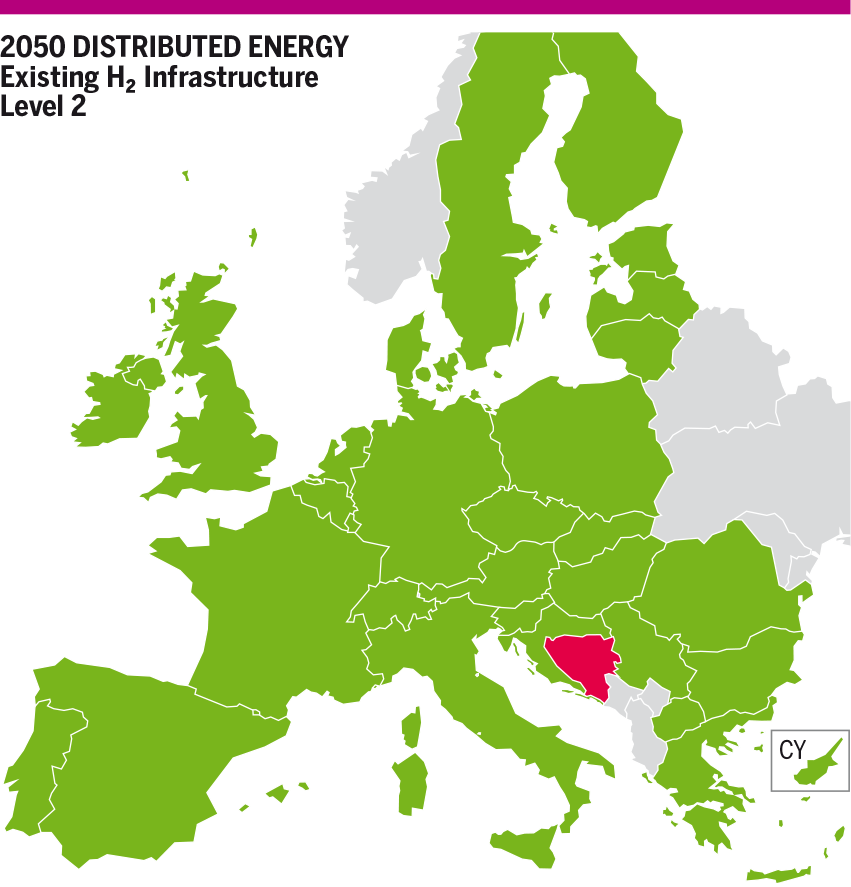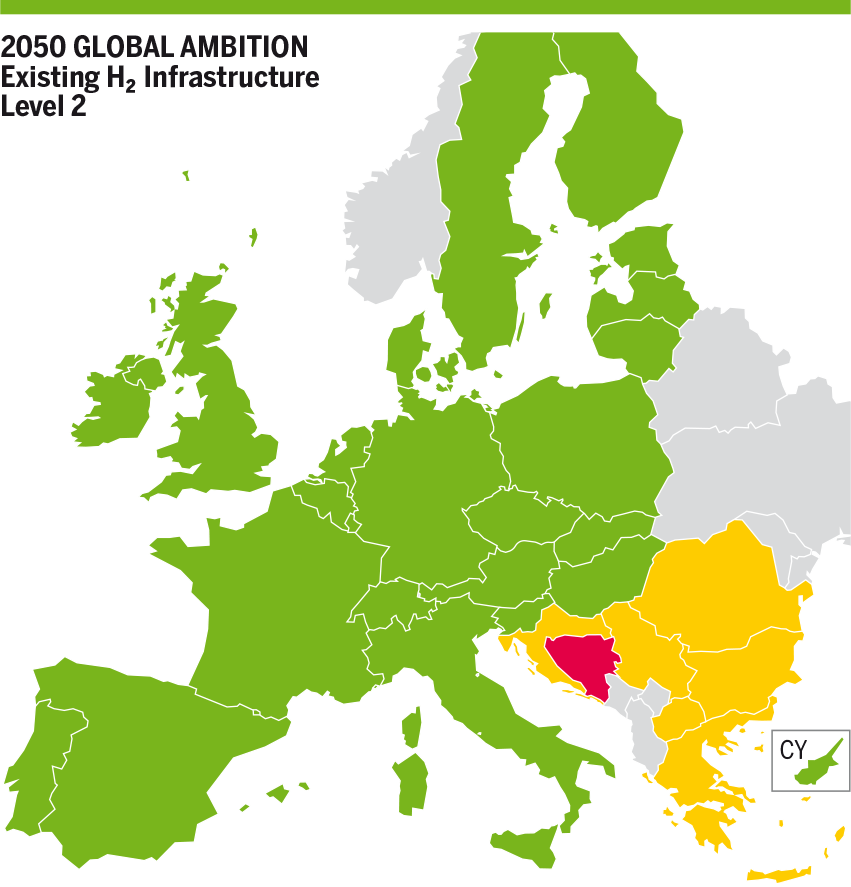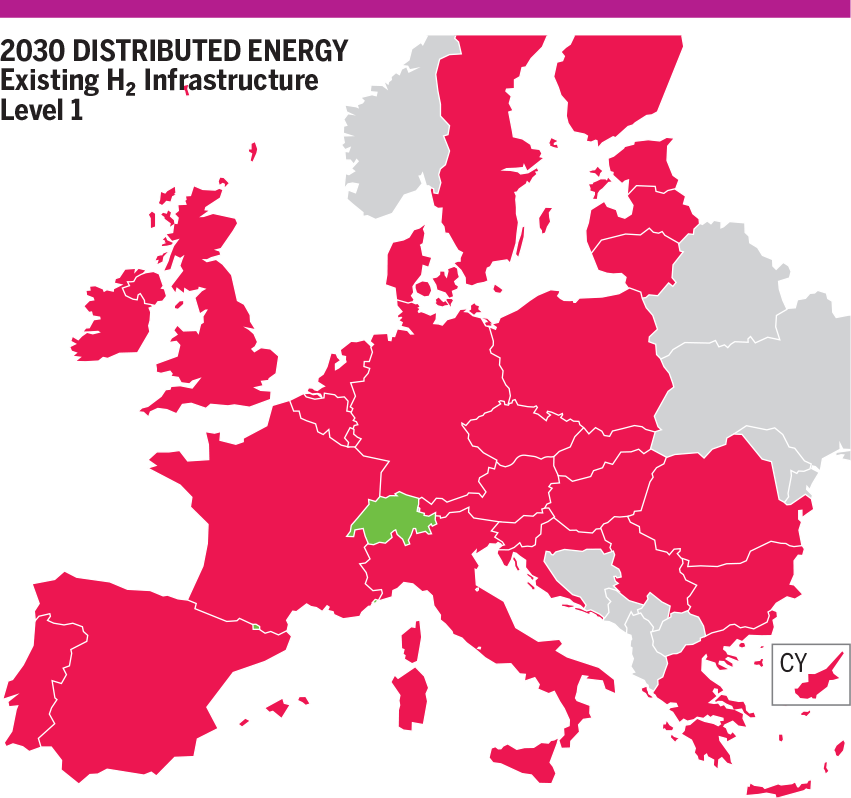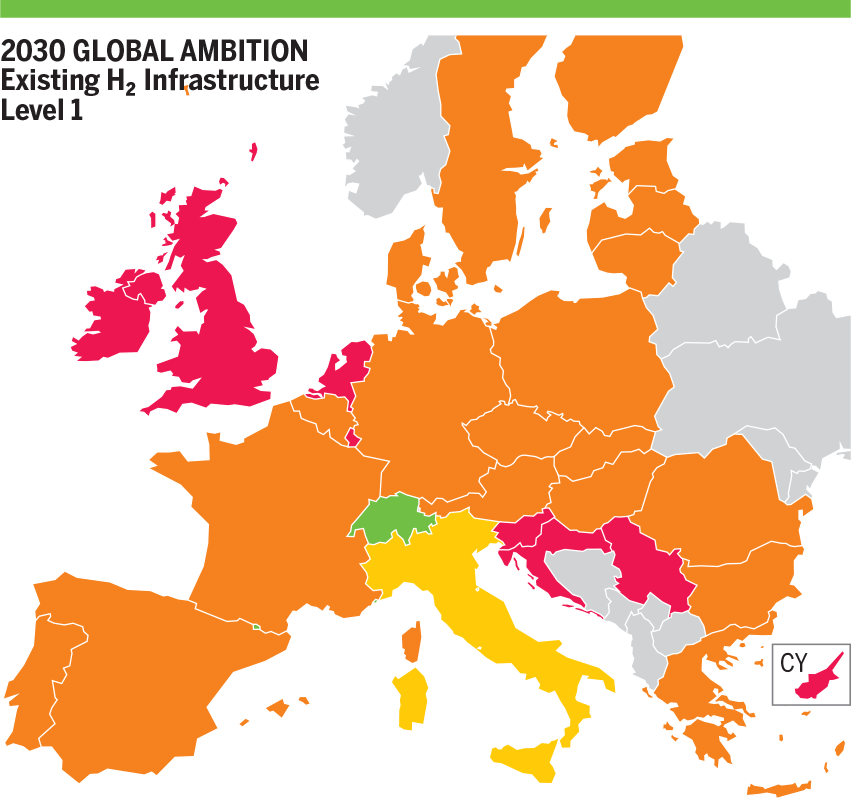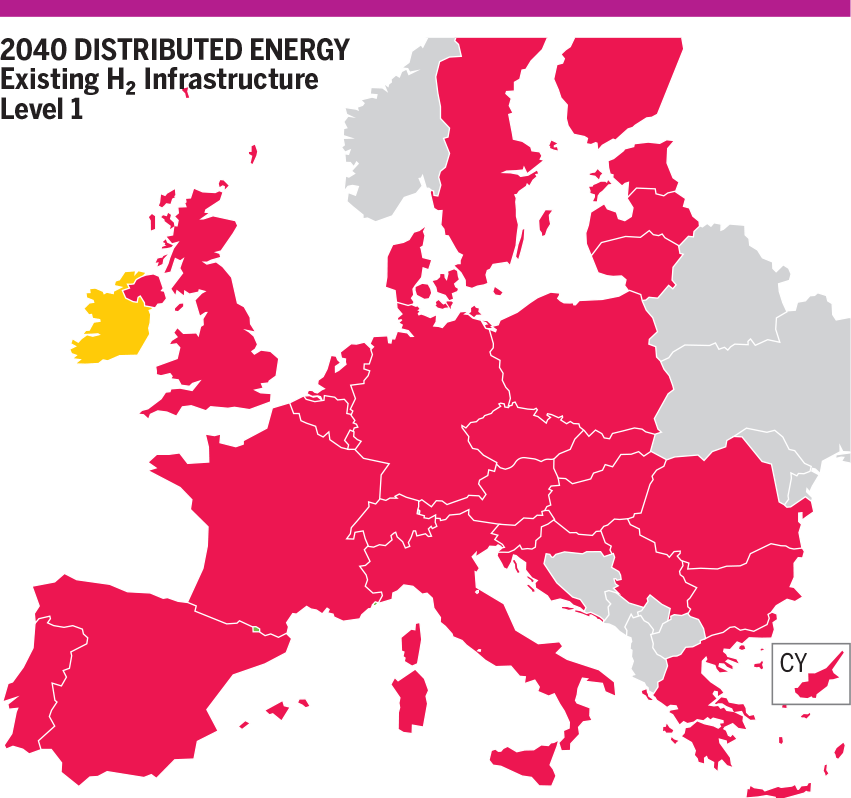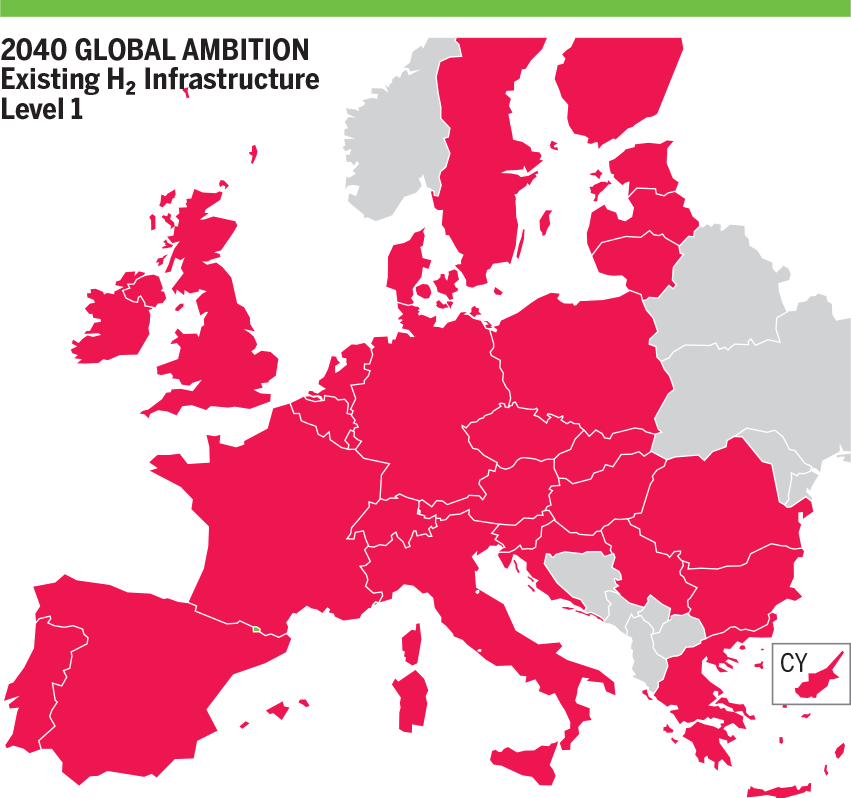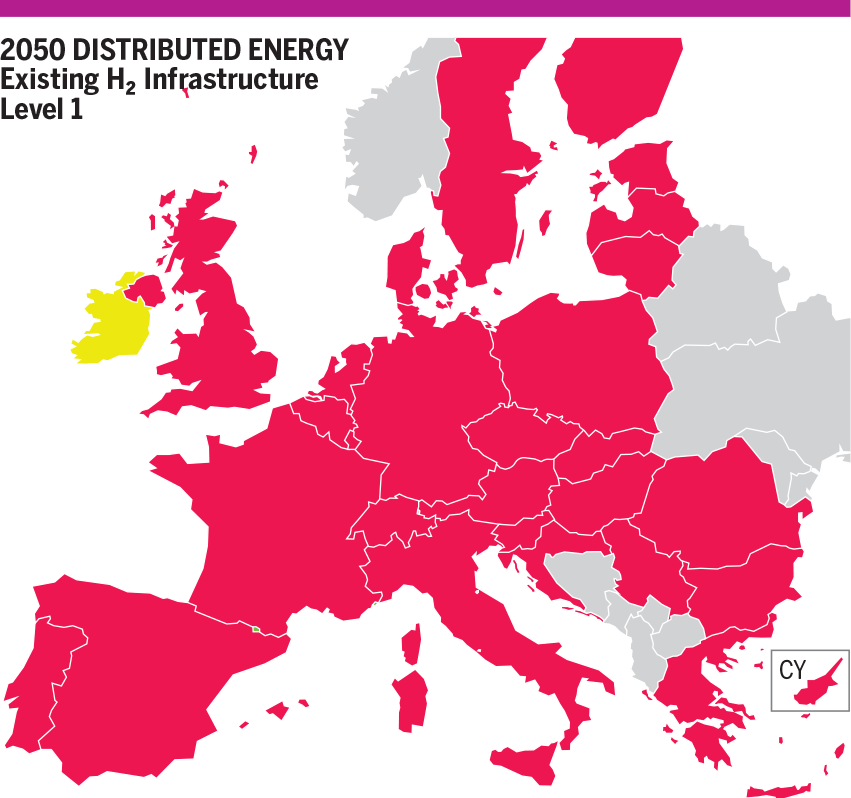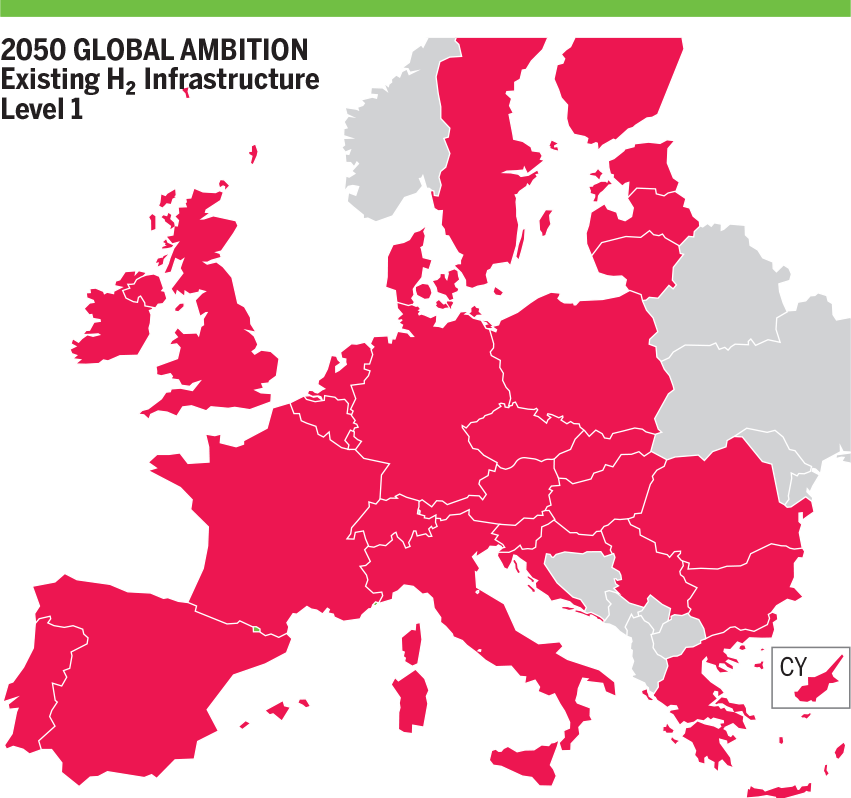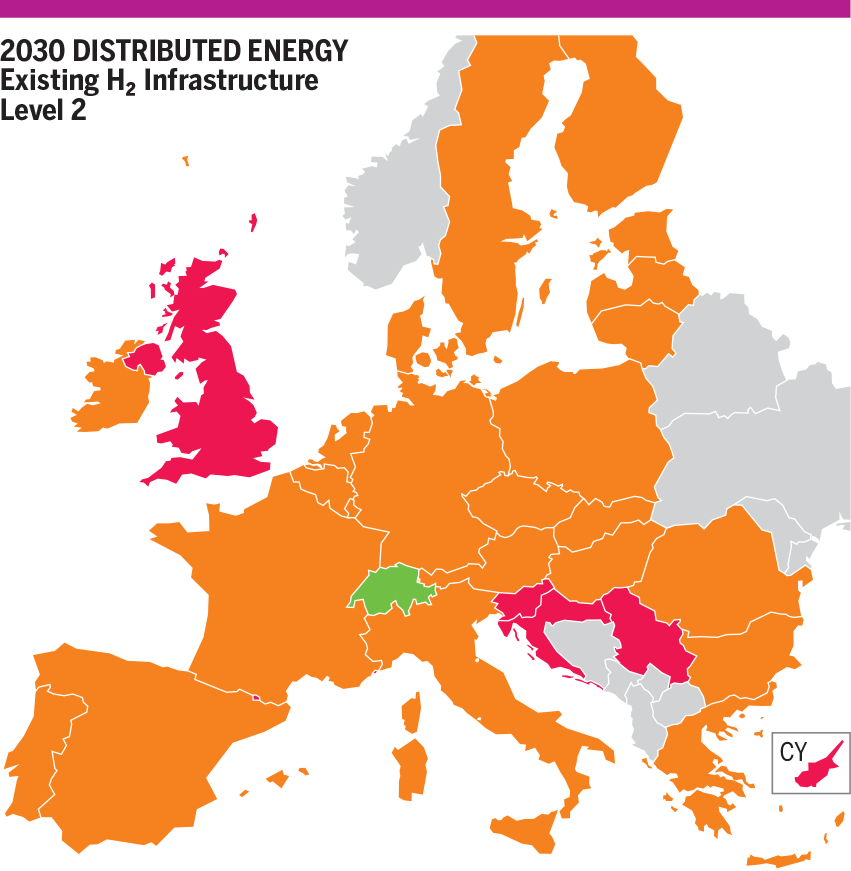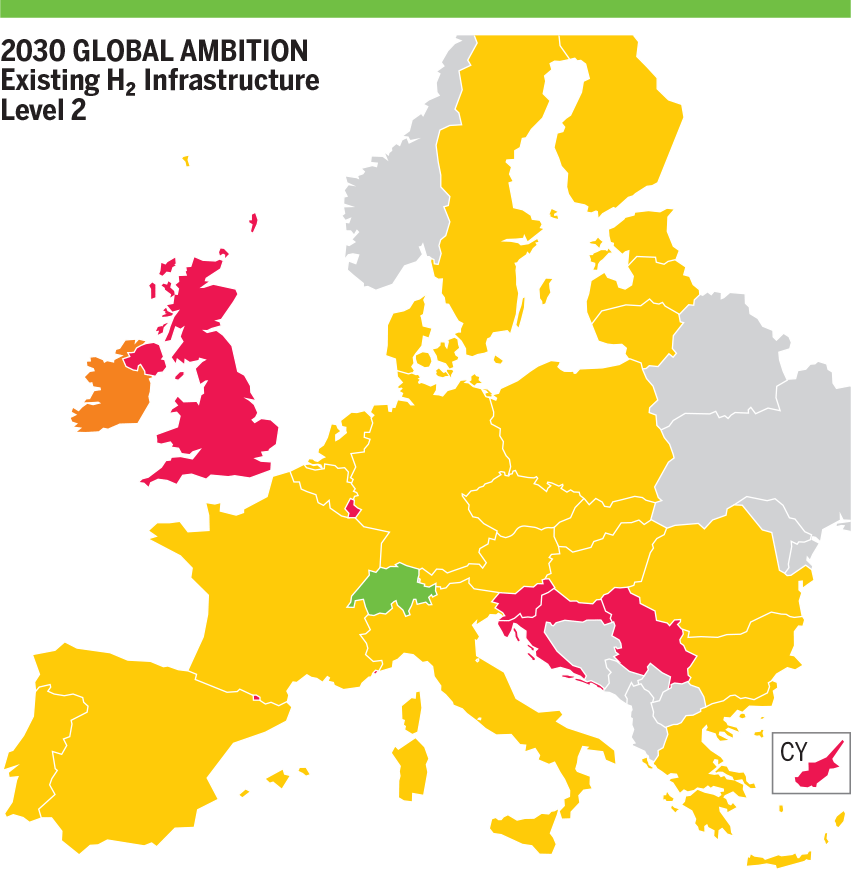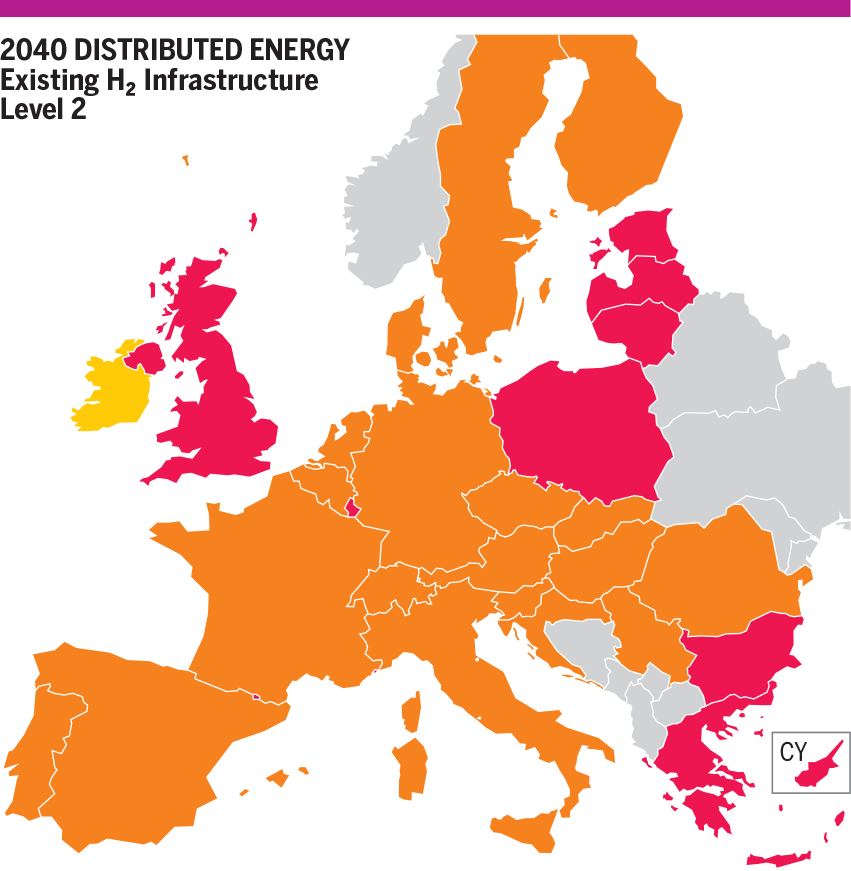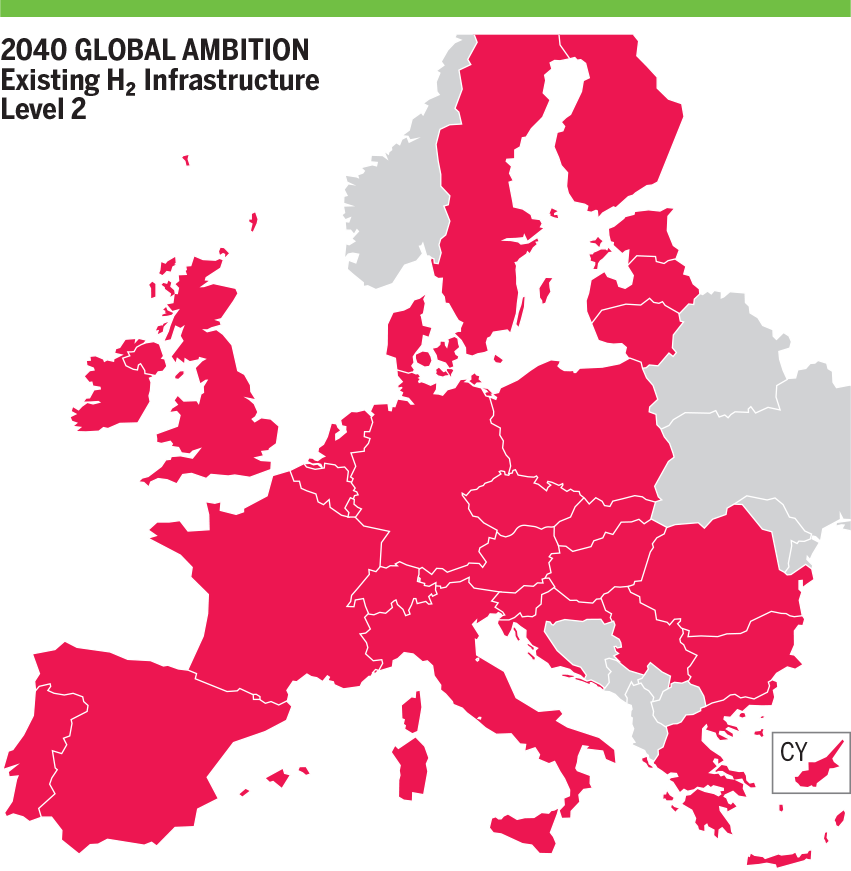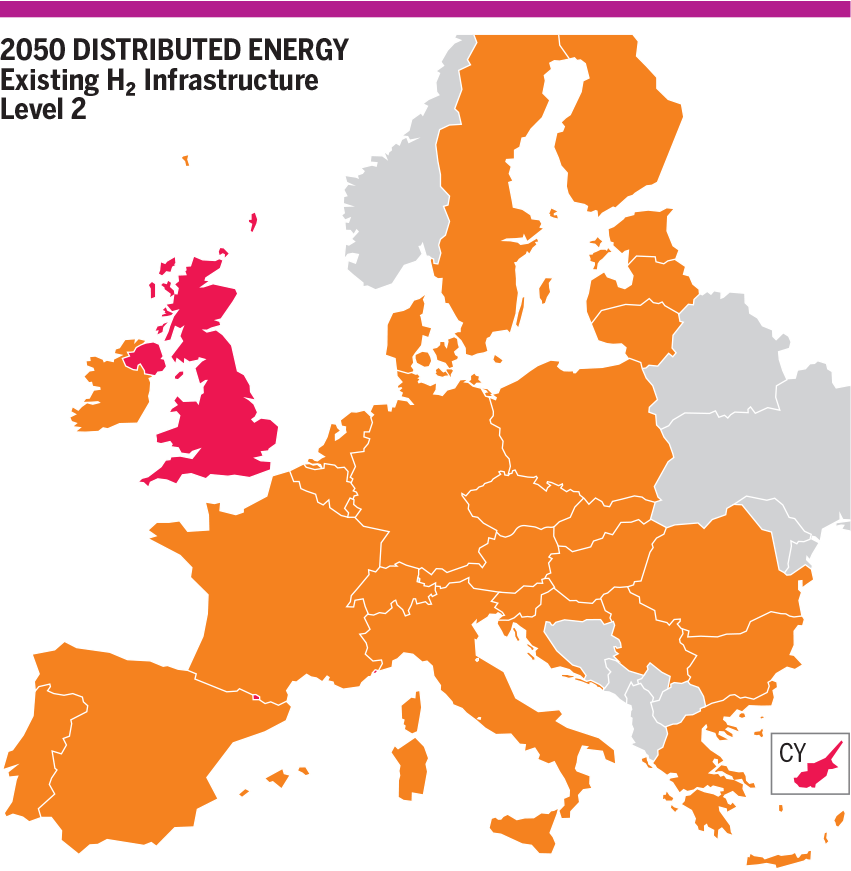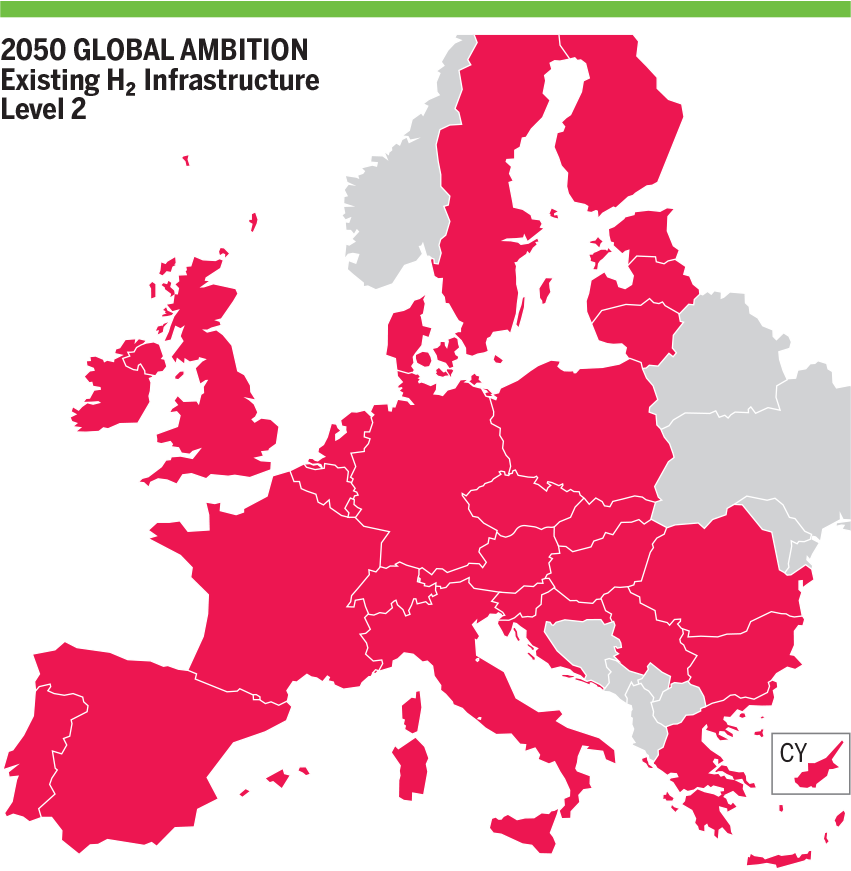Picture courtesy of GAZ-SYSTEM
12 Liquefied Hydrogen Supply Disruption
Liquefied Hydrogen supply disruption does not impact simulations results in 2025 Best Estimate and in National Trends demand scenarios (2030 and 2040); in those scenarios, there is no hydrogen import potential and methane demand curtailment is not impacted compared to the Reference Case. The infrastructure assessment is therefore limited to Distributed Energy and Global Ambition demand scenarios in 2030, 2040 and 2050.
12.1 Yearly demand
12.1.1 Methane Results
12.1.1.1 Existing Infrastructure
Liquefied Hydrogen supply disruption shows 4 % demand curtailment in 2040 in Infrastructure Level 1, in Global Ambition scenario, in Hungary, Romania, Serbia, Bulgaria and North Macedonia. Additional hydrogen production using methane create demand curtailment in these countries.
12.1.1.2 Advanced and PCI Infrastructure
Demand curtailment is fully mitigated in Advanced and PCI infrastructure levels.
12.1.2 Hydrogen Results
12.1.2.1 Existing Infrastructure
- 2030
H₂ Infrastructure Level 1
In Distributed Energy scenario, the Netherlands shows 23 % demand curtailment. Belgium and Germany cannot cooperate more with The Netherlands due to infrastructure limitations. Countries without any interconnections are curtailed: Ireland 33 %, United Kingdom 46 %, Luxembourg 61 %, Slovenia 86 % and Serbia 100 %. Other countries compensate the Liquefied Hydrogen supply disruption with additional Hydrogen produced with methane due to the flexibility of the methane infrastructure.
In Global Ambition scenario, the Netherlands shows 1 % demand curtailment. Belgium and Germany cannot cooperate more with The Netherlands due to infrastructure limitations. Countries without any interconnections are curtailed: Ireland 37 %, United Kingdom 46 %, Luxembourg 55 %, Slovenia 89 % and Serbia 100 %. Other countries compensate the Liquefied Hydrogen supply disruption with additional Hydrogen produced with methane due to the flexibility of the methane infrastructure.
H₂ Infrastructure Level 2
In both scenarios, all countries fully mitigate demand curtailment due to new interconnections and increased capacities and additional hydrogen production using methane. Only United Kingdom shows 44 % and 46 % demand curtailment in Distributed Energy scenario and in Global Ambition scenario still show a dependence with Liquefied Hydrogen.
- 2040
H₂ Infrastructure Level 1
In Distributed Energy scenario, most of the countries show 10 % demand curtailment. Italy, Switzerland, Slovenia and Austria show 8 % demand curtailment and Eastern countries (Slovakia, Hungary, Croatia, Romania, Bulgaria and Greece) show 3 % demand curtailment. Those countries cannot cooperate more due to infrastructure limitations (bottlenecks). Portugal shows 8 % demand curtailment and cannot cooperate more with Spain to mitigate Spain demand curtailment due to infrastructure limitation. United Kingdom (67 %), Luxembourg (83 %) and Serbia (100 %) are curtailed due to no interconnections with neighbouring countries.
In Global Ambition scenario, the situation is similar. Most of the countries show 22 % demand curtailment. Italy, Switzerland, Slovenia and Austria show 20 % demand curtailment and Eastern countries (Slovakia, Hungary, Croatia, Romania, Bulgaria and Greece) show 15 % demand curtailment. Those countries cannot cooperate more due to infrastructure limitations (bottlenecks). Ireland (50 %), United Kingdom (71 %), Luxembourg (86 %) and Serbia (100 %) are curtailment due to no interconnections with neighbouring countries.
H₂ Infrastructure Level 2
In Distributed Energy scenario, due to the additional interconnections and the additional hydrogen production using methane, most of the countries in the south (Portugal, Spain and Italy) and countries in the East (Austria, Slovakia, Hungary, Croatia, Serbia, Romania, Bulgaria and Greece) fully mitigate their demand curtailment. Ireland fully mitigates its demand curtailment The other countries show a low demand curtailment (1 %) except for United Kingdom with 3 % demand curtailment.
In Global Ambition scenario, due to the additional interconnections and the additional hydrogen production using methane, Italy and countries in the East (Austria, Slovakia, Hungary, Croatia, Serbia, Romania, Bulgaria and Greece) fully mitigate their demand curtailment. Ireland fully mitigates its demand curtailment The other countries show 4 % to 6 % demand curtailment. Countries which are not curtailed cannot cooperate with other countries due to infrastructure limitations (bottlenecks).
- 2050
H₂ Infrastructure Level 1
In Distributed Energy scenario, most of the countries show demand curtailment to 21 %. Eastern countries (Slovakia, Hungary, Croatia, Romania, Bulgaria and Greece) show 3 % demand curtailment. Those countries cannot cooperate more due to infrastructure limitations (bottlenecks). Portugal shows 8 % demand curtailment and cannot cooperate with Spain due to a bottleneck. United Kingdom (26 %), Luxembourg (87 %) and Serbia (100 %) are curtailed due to no interconnections with neighbouring countries. Ireland shows no demand curtailment.
In Global Ambition scenario, most of the countries show 33 % demand curtailment. Eastern countries (Slovakia, Hungary, Croatia, Romania and Bulgaria) show 31 % demand curtailment and cannot cooperate more due to infrastructure limitations (bottlenecks). Greece shows 39 % demand curtailment and Bulgaria cannot cooperate more due to a bottleneck). Portugal shows 28 % demand curtailment and cannot cooperate with Spain due to infrastructure limitations. France shows 28 % demand curtailment and cannot cooperate more with interconnected countries due to infrastructure limitations (bottlenecks). United Kingdom (45 %), Luxembourg (91 %) and Serbia(100 %) are curtailed due to no interconnections with neighbouring countries. Ireland shows 22 % demand curtailment.
H₂ Infrastructure Level 2
In Distributed Energy scenario, Spain and Portugal show 2 % demand curtailment and cannot cooperate with France due to infrastructure limitation. Most of the countries show 6 % demand curtailment except for Italy, Eastern countries (Austria, Slovenia, Croatia, Slovakia, Hungary, Romania, Serbia, Bulgaria and Greece) and Ireland fully mitigate their demand curtailment.
In Global Ambition scenario, demand curtailment is fully mitigated for all countries.
12.1.2.2 Advanced and PCI Infrastructure
Results remain unchanged in the Advanced and PCI infrastructure level compared to Existing Infrastructure level.
12.2 2-Week Cold Spell demand
12.2.1 Methane Results
12.2.1.1 Existing Infrastructure
In all scenarios and years Bosnia shows demand curtailment due to a bottleneck with Serbia.
- 2030
H₂ Infrastructure Level 1
Only Global Ambition scenario shows some countries with demand curtailment. Romania, Serbia, North Macedonia and Bulgaria show 2 % demand curtailment. Without any hydrogen supply from Ukraine, hydrogen production from methane is used at the maximum and infrastructure limitations with neighbouring countries do not allow them to cooperate with curtailed countries.
H₂ Infrastructure Level 2
Only Global Ambition scenario shows the same countries with demand curtailment. Romania, Serbia, North Macedonia and Bulgaria show 3 % demand curtailment. In infrastructure Level 2, the potential of hydrogen production increases and these countries go to the maximum and infrastructure limitations (bottlenecks) with neighbouring countries do not allow them to cooperate with curtailed countries.
- 2040
H₂ Infrastructure Level 1
In Distributed Energy scenario, Romania, Serbia, North Macedonia, Greece and Bulgaria show 2 % demand curtailment. Without any hydrogen supply from Ukraine, hydrogen production from methane is used at the maximum and infrastructure limitations with neighbouring countries do not allow them to cooperate with curtailed countries.
In Global Ambition scenario, Romania, Serbia, North Macedonia, Greece and Bulgaria show 2 % demand curtailment. Without any hydrogen supply from Ukraine, hydrogen production from methane is used at the maximum and infrastructure limitations with neighbouring countries do not allow them to cooperate with curtailed countries.
H₂ Infrastructure Level 2
In Distributed Energy scenario, Romania, Serbia, North Macedonia and Bulgaria show 12 % demand curtailment. Greece shows only 2 % demand curtailment and cannot cooperate more with Bulgaria due to a bottleneck. Without any hydrogen supply from Ukraine, hydrogen production from methane is used at the maximum and infrastructure limitations with neighbouring countries do not allow them to cooperate with curtailed countries.
In Global Ambition scenario, countries need more hydrogen and Romania, Serbia, North Macedonia, Greece and Bulgaria show 16 % demand curtailment. Without any hydrogen supply from Ukraine, hydrogen production from methane is used at the maximum and infrastructure limitations with neighbouring countries do not allow them to cooperate with curtailed countries.
- 2050
H₂ Infrastructure Level 1
In Distributed Energy and Global Ambition scenario, Ukrainian hydrogen supply disruption does not create any methane curtailment.
H₂ Infrastructure Level 2
Only the Global Ambition scenario shows some countries with demand curtailment. Romania, Serbia, North Macedonia, Greece and Bulgaria show 8 % to 9 % demand curtailment. Croatia shows only 1 % demand curtailment. Without any hydrogen supply from Ukraine, hydrogen production from methane is used at the maximum and infrastructure limitations (bottlenecks) with neighbouring countries do not allow them to cooperate with curtailed countries.
12.2.1.2 Advanced and PCI Infrastructure
There is no demand curtailment at all in any year of any scenario.
12.2.2 Hydrogen Results
12.2.2.1 Existing Infrastructure
- 2030
H₂ Infrastructure Level 1
In Distributed Energy scenario, all countries are curtailed. Most of the countries show 24 % demand curtailment. Italy with more supply from North Africa, shows 15 % demand curtailment and cannot cooperate more with Austria to mitigate demand curtailment in the north. Other countries not interconnected show highest demand curtailment: Serbia (100 %), Slovenia (89 %), United Kingdom (71 %), Luxembourg (70 %), Croatia (38 %) and Ireland (43 %). The Netherlands, shows 57 % demand curtailment and Belgium and Germany cannot cooperate more with The Netherlands due to infrastructure limitations (bottlenecks).
In Global Ambition scenario, all countries show demand curtailment except for Italy. Most the countries show 15 % demand curtailment. Other countries not interconnected show highest demand curtailment: Serbia (100 %), Slovenia (89 %), United Kingdom (69 %), Luxembourg (66 %), Croatia (32 %) and Ireland (46 %). The Netherlands, shows 46 % demand curtailment and Belgium and Germany cannot cooperate more with The Netherlands due to bottlenecks.
H₂ Infrastructure Level 2
In Distributed Energy scenario, due to additional interconnections and more hydrogen production using methane, all countries mitigate their demand curtailment. Ireland fully mitigates its demand curtailment. Most of the countries show 18 % demand curtailment. Italy and Luxembourg show 15 % demand curtailment. Italy cannot cooperate with Austria due to a bottleneck. Other countries not interconnected show higher values of demand curtailment: Serbia (41 %), Croatia (401), Slovenia (29 %) and United Kingdom (64 %).
In Global Ambition scenario, due to additional interconnections and more hydrogen production using methane, all countries mitigate their demand curtailment. Ireland fully mitigates its demand curtailment. Most of the countries show 10 % demand curtailment. Eastern countries (Romania, Hungary, Bulgaria, Greece and Slovakia) and Austria show 6 % demand curtailment and cannot cooperate with other countries due to infrastructure limitations. Other countries not interconnected mitigate their demand curtailment: United Kingdom (64 %), Serbia (41 %), Croatia (40 %), Slovenia (32 %), Luxembourg (17 %).
- 2040
H₂ Infrastructure Level 1
In Distributed Energy scenario, most of the countries show 40 % demand curtailment. Ireland shows no demand curtailment and can satisfy its demand with its own production. Eastern countries (Bulgaria, Greece, Slovakia, Croatia, Hungary, Romania) show 34 % demand curtailment and cannot cooperate more with interconnected countries due to infrastructure limitations (bottlenecks). Serbia (100 %), Luxembourg (87 %) and United Kingdom (83 %) are isolated and cannot satisfy their demand with their own production.
In Global Ambition scenario, most of the countries show 54 % demand curtailment. Serbia (100 %), Luxembourg (91 %), United Kingdom (85 %) and Ireland (69 %) are isolated and cannot satisfy their demand with their own production.
H₂ Infrastructure Level 2
In Distributed Energy scenario, due to additional interconnections and more hydrogen production using methane, all countries mitigate demand curtailment. Most of the countries show 26 % demand curtailment. Eastern countries (Slovakia, Croatia, Hungary, Romania and Serbia) show 16 % demand curtailment and cannot cooperate more with interconnected countries due to bottlenecks. United Kingdom shows 40 % demand curtailment and Ireland and Belgium cannot cooperate more due to infrastructure limitations. Greece and Bulgaria show 28 % demand curtailment and Romania cannot cooperate more with Bulgaria due to a bottleneck.
In Global Ambition scenario, due to additional interconnections and more hydrogen production using methane, all countries mitigate demand curtailment. Most of the countries show 37 % demand curtailment. Ireland shows 22 % demand curtailment and Ireland and Belgium cannot cooperate with United Kingdom (41 %) to mitigate its demand curtailment due to infrastructure limitations.
- 2050
H₂ Infrastructure Level 1
In Distributed Energy scenario, most of the countries show 47 % demand curtailment. Eastern countries (Greece, Slovakia, Bulgaria, Croatia, Hungary and Romania) show 32 % demand curtailment and cannot cooperate with other countries due to infrastructure limitations. Portugal shows 32 % demand curtailment and cannot more cooperate with Spain due to a bottleneck. Some countries are still not interconnected and show demand curtailment: United Kingdom (57 %), Serbia (100 %) and Luxembourg (90 %). Ireland can satisfy its demand with its own production.
In Global Ambition scenario, most of the countries show 61 % demand curtailment. Ireland shows 51 % demand curtailment and cannot cooperate more with United Kingdom (68 % demand curtailment) due to infrastructure limitations. Some countries are still not interconnected and show demand curtailment: United Kingdom (68 %), Serbia (100 %) and Luxembourg (94 %). Greece shows 65 % demand curtailment rate and Bulgaria cannot cooperate to mitigate Greece demand curtailment due to a bottleneck).
H₂ Infrastructure Level 2
In Distributed Energy scenario, due to additional interconnections and more hydrogen production using methane, all countries mitigate demand curtailment. Most of the countries show 22 % demand curtailment. Eastern countries (Slovakia, Croatia, Hungary, Romania and Serbia) show 15 % demand curtailment and cannot cooperate more with interconnected countries due to infrastructure limitations. United Kingdom shows 34 % demand curtailment and Ireland and Belgium cannot cooperate more due to bottlenecks.
In Global Ambition scenario, due to additional interconnections and more hydrogen production using methane, all countries mitigate demand curtailment. Most of the countries show 25 % demand curtailment. Southern countries (Portugal, France, Italy and Spain) show 22 % demand curtailment and cannot cooperate with interconnected countries due to infrastructure limitations.
12.2.2.2 Advanced and PCI Infrastructure
Advanced and PCI methane infrastructure levels do not change simulation results in existing. Advanced and PCI infrastructure levels add more flexibility on the methane side, but hydrogen production is capped and this additional flexibility cannot be used.
12.3 2-Week Dunkelflaute demand
The 2-Week Dunkelflaute country demands are generally very similar to the 2-Week Cold Spell demand values. Hydrogen demand is the same for Best Estimate and National Trends scenarios and it is also the same in the year 2030 of Distributed Energy and Global Ambition scenarios. Regarding Distributed Energy and Global Ambition scenarios in 2040 and 2050, only Italy, The Netherlands, Romania and United Kingdom show higher values in 2-Week Dunkelflaute.
Regarding the methane demand values, only Bulgaria, Czech Republic, Germany, Croatia and Italy present slight differences when comparing demand of 2-Week Dunkelflaute with 2-Week Cold in Best Estimate and National trends scenarios.
In Distributed Energy and Global Ambition scenarios just Spain, France, Greece, Italy, The Netherlands, Portugal, Romania and United Kingdom present higher methane demand in 2-Week Dunkelflaute.
Consequently, the curtailment rate results in 2-Week Dunkelflaute and in 2-Week Cold Spell are exactly the same for most of the countries. The countries with higher demand in 2-Week Dunkelflaute are only increasing their demand curtailment rate in 1 or 2 % maximum.
12.4 Peak demand
12.4.1 Methane Results
12.4.1.1 Existing Infrastructure
- 2030
H₂ Infrastructure Level 1
The Distributed Energy scenario shows some countries with demand curtailment. Romania, Serbia, North Macedonia, Greece and Bulgaria show 7 % demand curtailment. Without any hydrogen supply from Ukraine, hydrogen production from methane is used at the maximum and infrastructure limitations with neighbouring countries do not allow them to cooperate with curtailed countries.
The Global Ambition scenario shows some countries with demand curtailment. Romania, Serbia, North Macedonia, Greece and Bulgaria show 18 % demand curtailment. Sweden shows 21 % demand curtailment due to a very high methane peak demand. Without any hydrogen supply from Ukraine, hydrogen production from methane is used at the maximum and infrastructure limitations with neighbouring countries do not allow them to cooperate with curtailed countries.
H₂ Infrastructure Level 2
In Distributed Energy scenario, the same countries show demand curtailment with highest values (10 %). In infrastructure level 2, the potential of hydrogen production using methane increases and these countries go to the maximum and infrastructure limitations with neighbouring countries do not allow them to cooperate with curtailed countries.
The Global Ambition scenario shows the same countries with highest demand curtailment (18 %).Sweden mitigates its demand curtailment to 14 % and Poland, Czech Republic and Slovakia show 1 % demand curtailment. In infrastructure level 2, the potential of hydrogen production increases and these countries go to the maximum and infrastructure limitations with neighbouring countries do not allow them to cooperate with curtailed countries.
- 2040
H₂ Infrastructure Level 1
In the Distributed Energy scenario, Romania, Serbia, North Macedonia, Greece and Bulgaria show 11 % demand curtailment. Without any hydrogen supply from Ukraine, hydrogen production from methane is used at the maximum and infrastructure limitations with neighbouring countries do not allow them to cooperate with curtailed countries.
In Global Ambition scenario, Romania, Serbia, North Macedonia, Greece and Bulgaria show 12 % demand curtailment and Sweden 11 %. Without any hydrogen supply from Ukraine, hydrogen production from methane is used at the maximum and infrastructure limitations (bottlenecks) with neighbouring countries do not allow them to cooperate with countries curtailed.
H₂ Infrastructure Level 2
In Distributed Energy scenario, Romania, Serbia, North Macedonia and Bulgaria show 24 % demand curtailment. Greece shows only 9 % demand curtailment and cannot cooperate more with Bulgaria due to a bottleneck. Without any hydrogen supply from Ukraine, hydrogen production from methane is used at the maximum and infrastructure limitations with neighbouring countries do not allow them to cooperate with curtailed countries.
In the Global Ambition scenario, countries need more hydrogen and Romania, Serbia, North Macedonia, Greece and Bulgaria show 27 % demand curtailment and Croatia 8 %. Without any hydrogen supply from Ukraine, hydrogen production from methane is used at the maximum and infrastructure limitations with neighbouring countries do not allow them to cooperate with curtailed countries.
- 2050
H₂ Infrastructure Level 1
In Distributed Energy and Global Ambition scenario, Ukrainian hydrogen supply disruption does not create any methane curtailment.
H₂ Infrastructure Level 2
Only the Global Ambition scenario shows some countries with demand curtailment. Romania, Serbia, North Macedonia, Greece and Bulgaria show 18 % demand curtailment. Croatia shows 13 % demand curtailment. Without any hydrogen supply from Ukraine, hydrogen production from methane is used at the maximum and infrastructure limitations with neighbouring countries do not allow them to cooperate with curtailed countries.
12.4.1.2 Advanced and PCI Methane
There is no demand curtailment in both scenarios and years except for in Sweden, in Global Ambition scenario in 2030 and 2040 in both hydrogen infrastructure levels due to a very high methane peak demand.
Demand curtailment values for Sweden remain unchanged compared to Existing Methane infrastructure level.
12.4.2 Hydrogen Results
12.4.2.1 Existing Infrastructure
- 2030
H₂ Infrastructure Level 1
In Distributed Energy scenario, all countries show demand curtailment. Most of the countries show 35 % demand curtailment. Italy with more supply from North Africa shows 30 % demand curtailment and cannot cooperate more with Austria due to a bottleneck. Some countries are not interconnected and show higher demand curtailment: United Kingdom (78 %), Luxembourg (74 %), Slovenia (91 %), Ireland (62 %), Croatia (49 %) and Serbia(100 %). The Netherlands shows 67 % demand curtailment and Belgium and Germany cannot cooperate more due to infrastructure limitations.
In Global Ambition scenario, all countries show demand curtailment. Most of the countries show 27 % demand curtailment. Italy, with more supply from North Africa, shows 16 % demand curtailment and cannot cooperate more with Austria due to infrastructure limitations. The Netherlands shows 58 % demand curtailment and Belgium and Germany cannot cooperate more due to bottlenecks.Some countries are not interconnected and show higher demand curtailment: United Kingdom (76 %), Luxembourg (71 %), Slovenia (94 %), Ireland (62 %), Croatia (45 %) and Serbia (100 %).
H₂ Infrastructure Level 2
In Distributed Energy scenario, due to additional interconnections and more hydrogen production using methane, all countries mitigate demand curtailment. Most of the countries show 27 % demand curtailment. Some countries are not interconnected and show higher demand curtailment: United Kingdom (70 %), Ireland (25 %), Croatia (49 %) and Serbia(49 %).
In Global Ambition scenario, thanks to additional interconnections and more hydrogen production using methane, all countries mitigate demand curtailment. Most of the countries show 19 % demand curtailment. Italy shows 16 % demand curtailment and cannot cooperate with Austria due to infrastructure limitations. Some countries are not interconnected and show higher demand curtailment: United Kingdom (69 %), Ireland (20 %), Croatia (48 %) and Serbia(49 %).
- 2040
H₂ Infrastructure Level 1
In Distributed Energy scenario, all countries show demand curtailment. Most of the countries show 48 % demand curtailment. Eastern countries (Greece, Croatia, Romania, Hungary, Bulgaria and Slovakia) show 43 % demand curtailment and cannot cooperate more with interconnected countries to mitigate demand curtailment due to infrastructure limitations (bottlenecks). Ireland shows 14 % demand curtailment. Some countries that are not interconnected and show a higher demand curtailment: United Kingdom (87 %), Luxembourg (88 %) and Serbia (100 %).
In Global Ambition scenario, most of the countries show 61 % to 66 % demand curtailment. The countries that are not interconnected and show higher demand curtailment: United Kingdom (90 %), Luxembourg (93 %), Ireland (81 %) and Serbia (100 %).
H₂ Infrastructure Level 2
In Distributed Energy scenario, all countries mitigate their demand curtailment. Most of the countries show 27 % to 30 % demand curtailment. Greece and Bulgaria show 35 % demand curtailment and Romania cannot cooperate more with Bulgaria due to a bottleneck. United Kingdom show 54 % demand curtailment and Ireland (16 %) and Belgium (29 %) cannot cooperate more due to infrastructure limitations (bottlenecks).
In Global Ambition scenario, all countries mitigate their demand curtailment. Most of the countries show 43 to 45 % demand curtailment. United Kingdom show 57 % demand curtailment and Ireland (52 %) and Belgium (44 %) cannot cooperate more due to infrastructure limitations (bottlenecks).
- 2050
H₂ Infrastructure Level 1
In Distributed Energy scenario, all countries show demand curtailment. Most of the countries show 55 % demand curtailment. Eastern countries (Greece, Croatia, Romania, Hungary, Bulgaria and Slovakia) show 42 % demand curtailment and cannot cooperate with interconnected countries to mitigate demand curtailment due to infrastructure limitations. Some countries are not interconnected and show higher demand curtailment: United Kingdom (68 %), Luxembourg (91 %), Ireland (8 %) and Serbia(100 %).
In Global Ambition scenario, all countries show curtailment and most of the countries show 68 % demand curtailment. Some countries are not interconnected and show higher demand curtailment: United Kingdom (79 %), Luxembourg (95 %), Ireland (69 %) and Serbia (100 %).
H₂ Infrastructure Level 2
In Distributed Energy scenario, all countries mitigate demand curtailment. Ireland mitigates its demand curtailment to 22 % and most of the countries mitigate their demand curtailment to 27 %. United Kingdom mitigates its demand curtailment to 49 %.
In Global Ambition scenario, all countries mitigate demand curtailment. Most of the countries mitigate their demand curtailment to 33 %. United Kingdom and Ireland mitigate their demand curtailment to 49 %. Greece, Bulgaria and Romania show 35 % demand curtailment and interconnected countries cannot cooperate more with them due to bottlenecks.
12.4.2.2 Advanced and PCI
Advanced and PCI methane infrastructure levels do not change simulation results compared to Existing. Advanced and PCI infrastructure levels add more flexibility on the methane side, but hydrogen production is capped, and this additional flexibility cannot be used.


